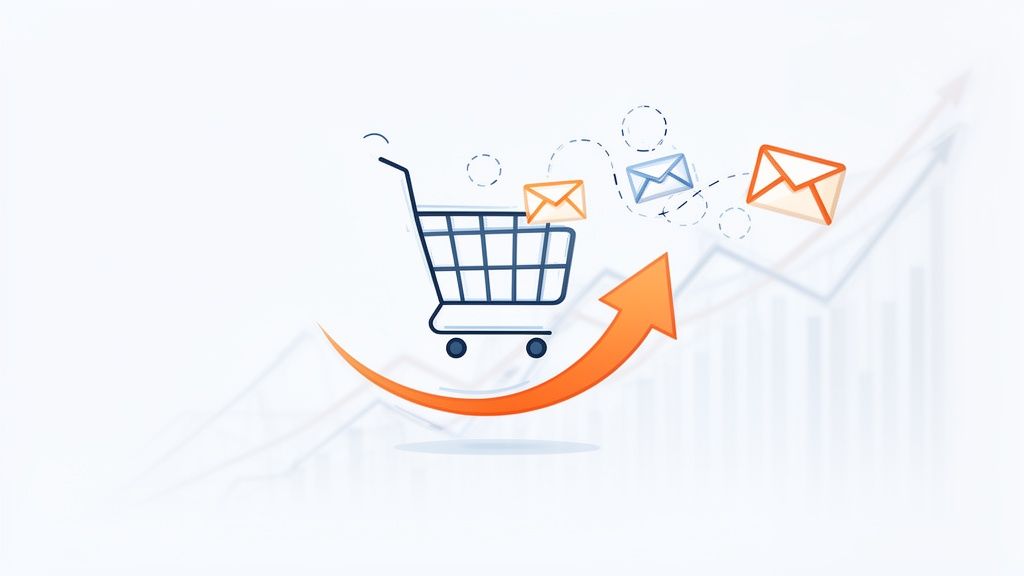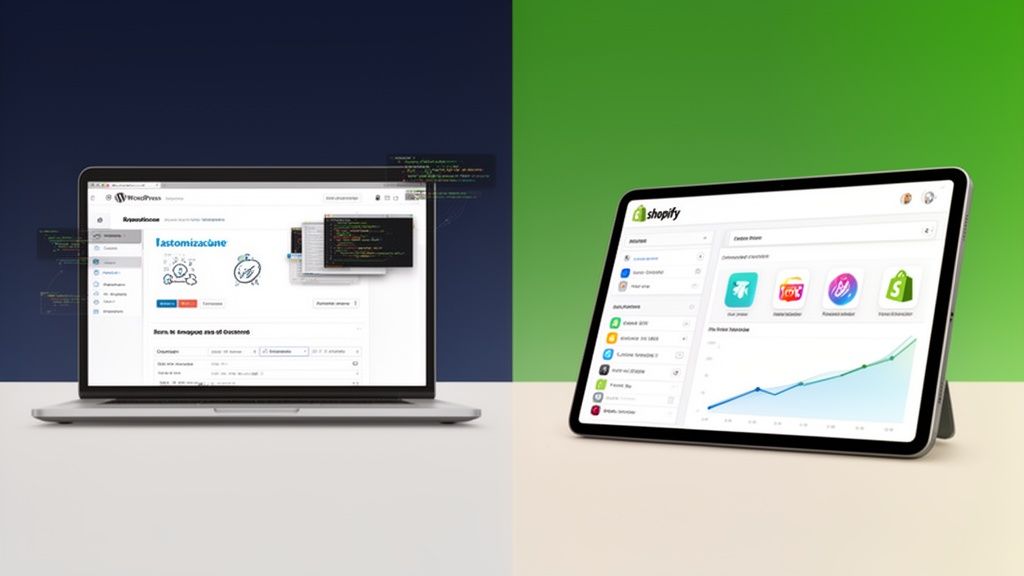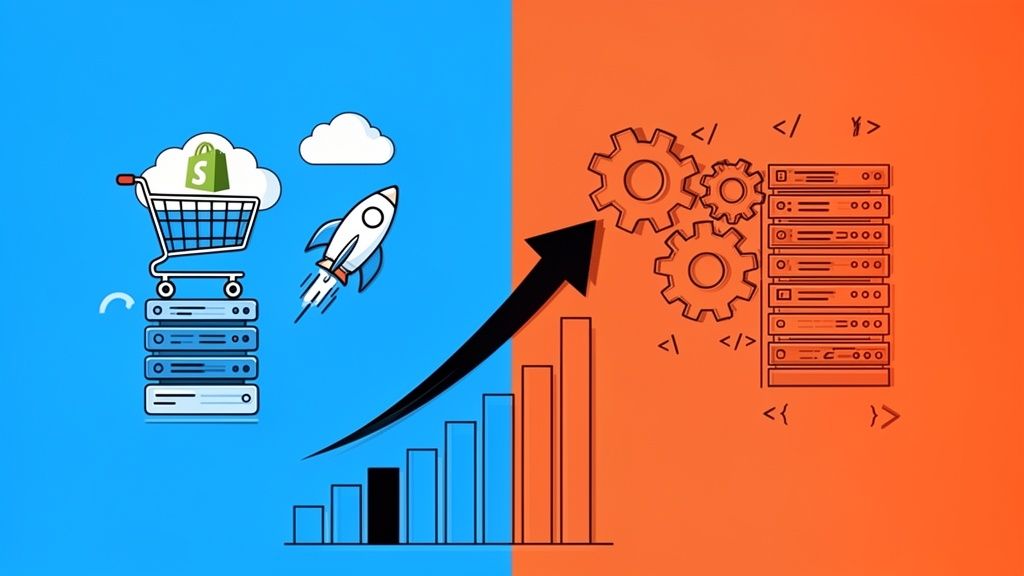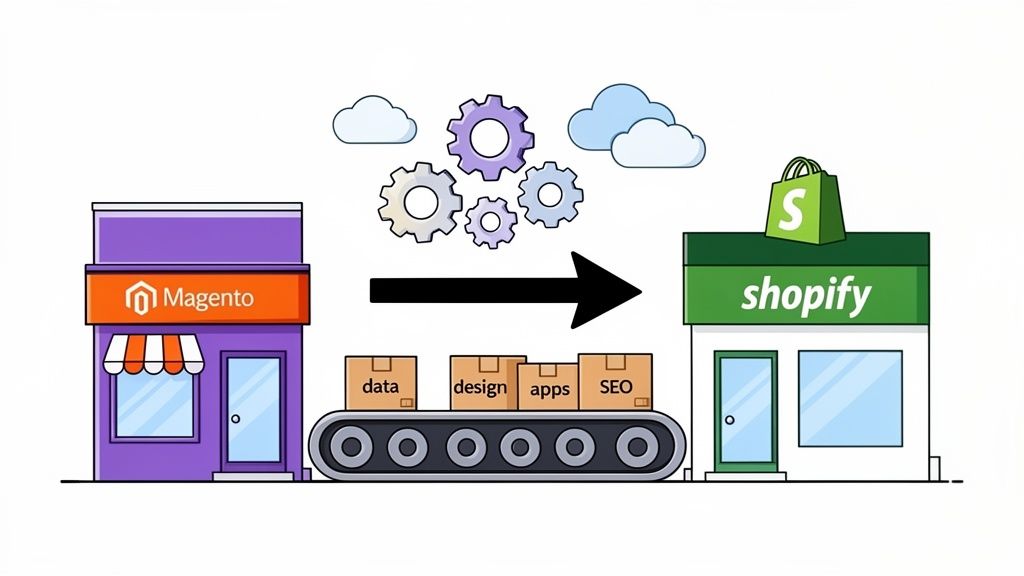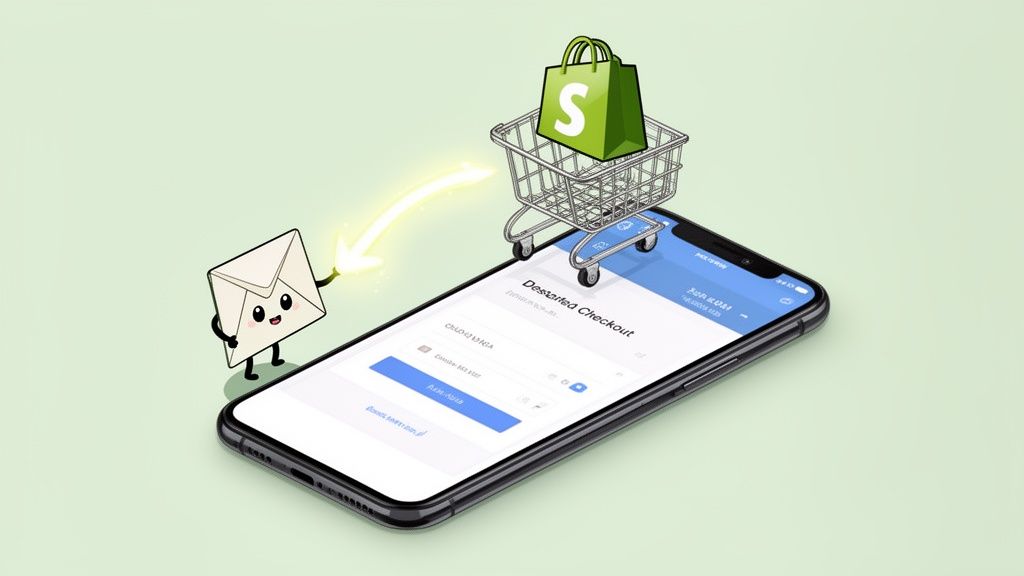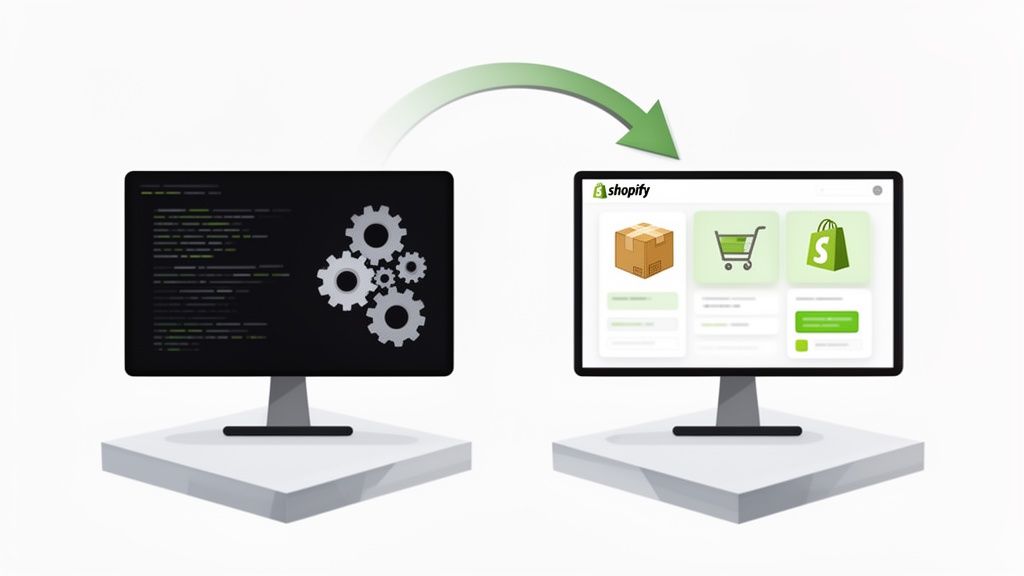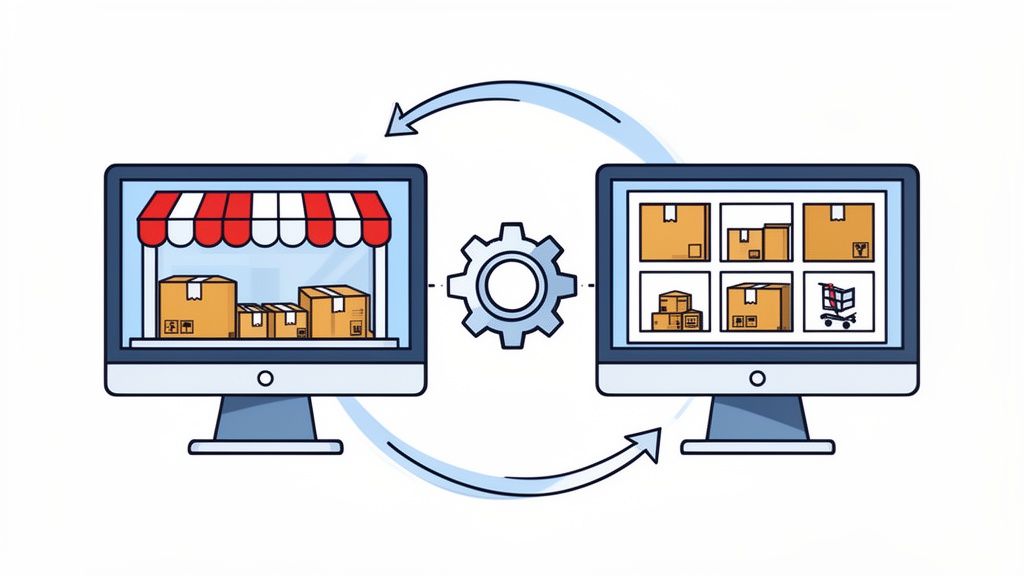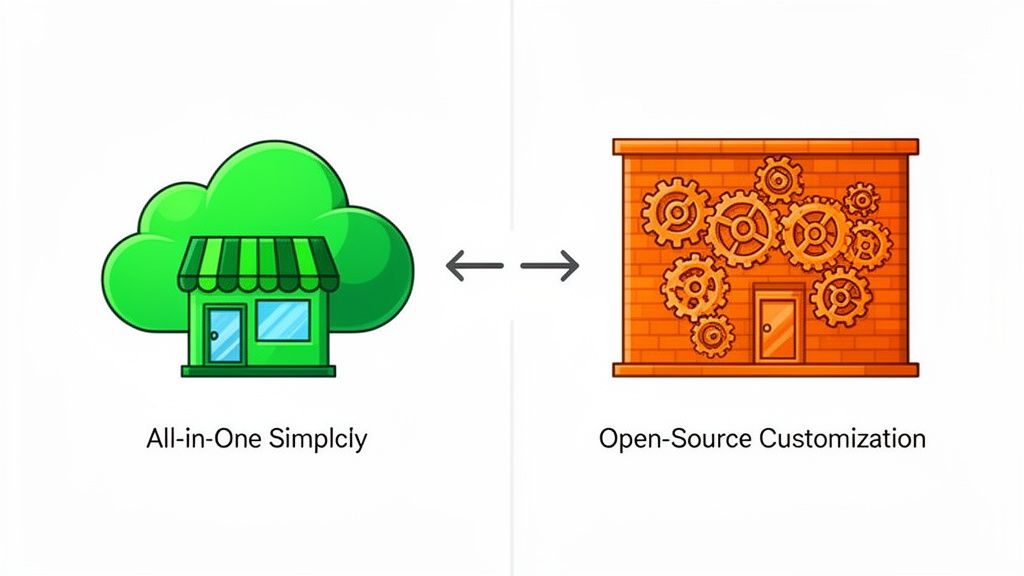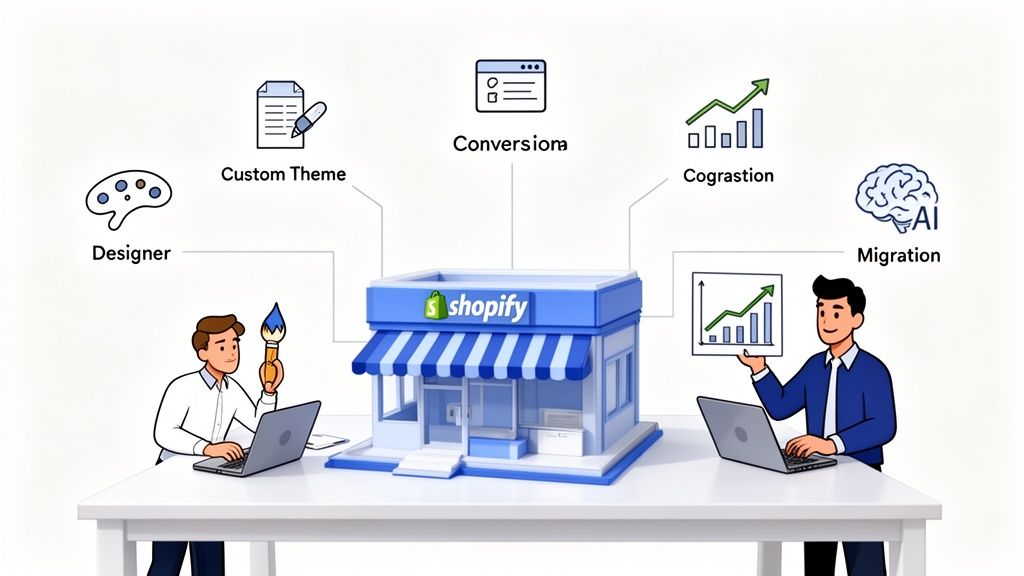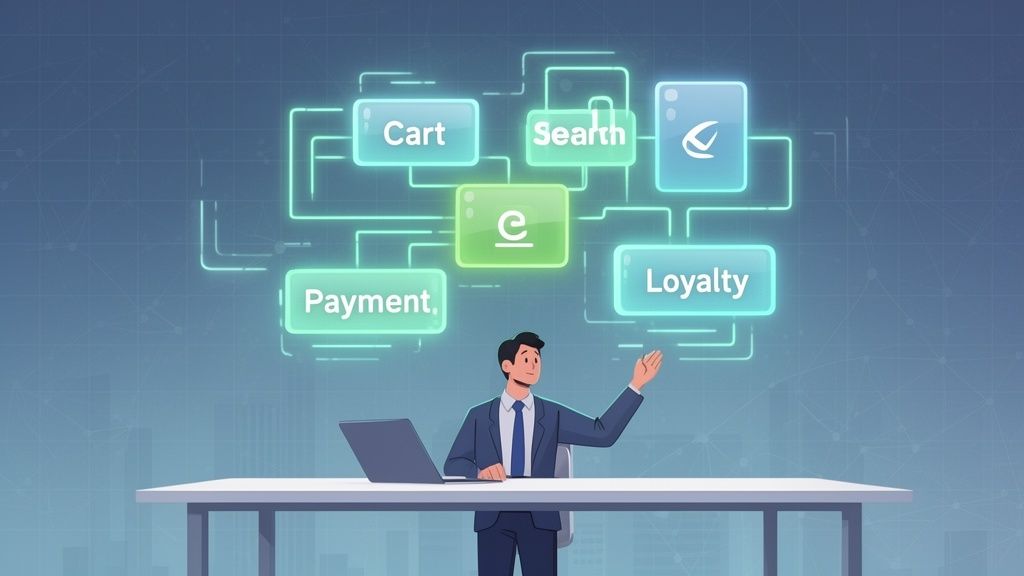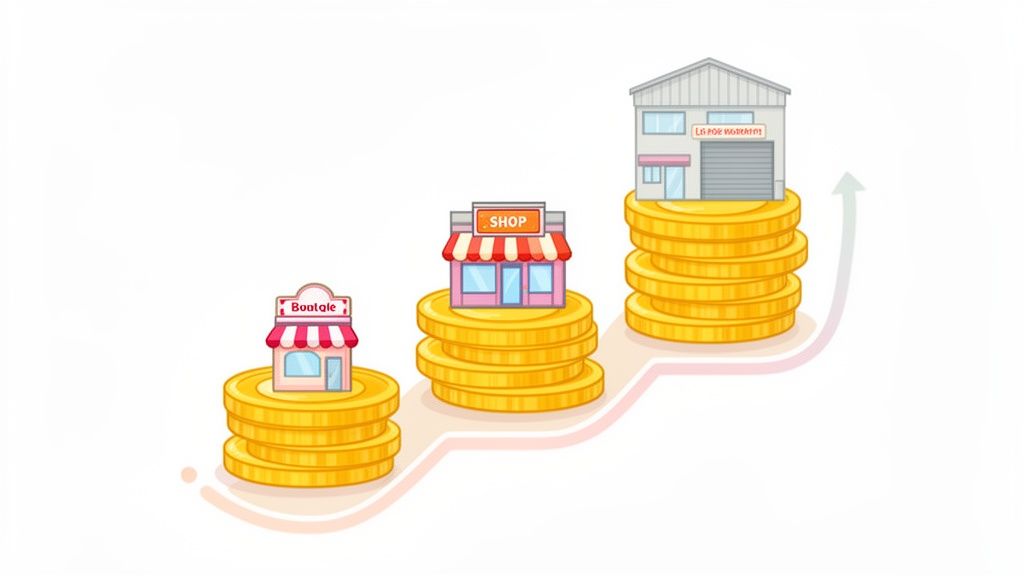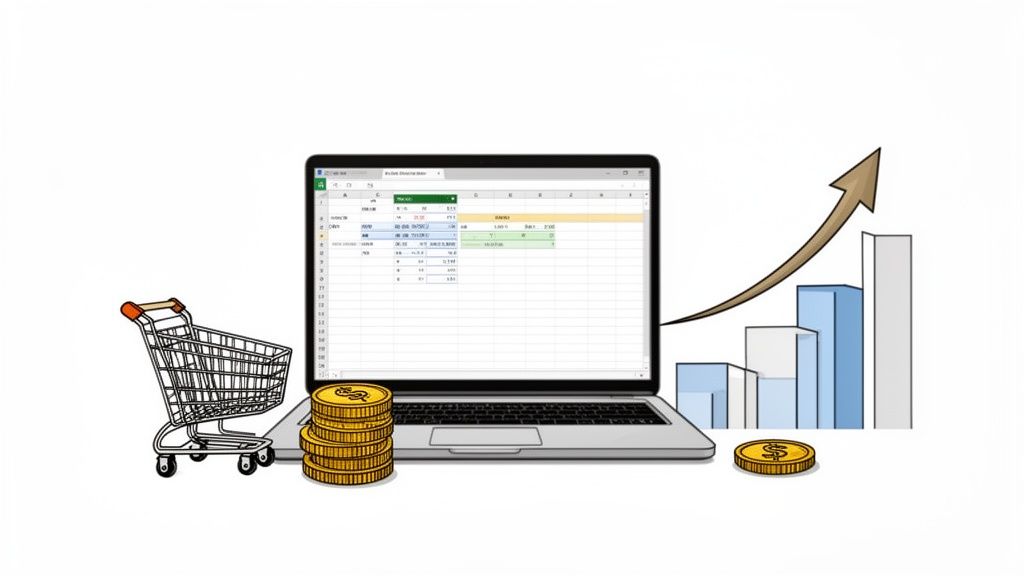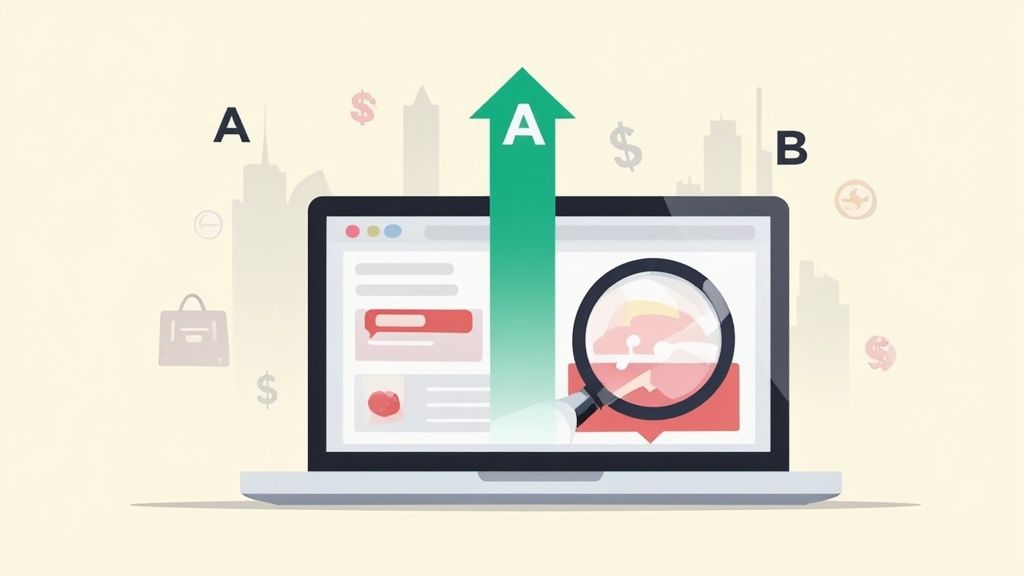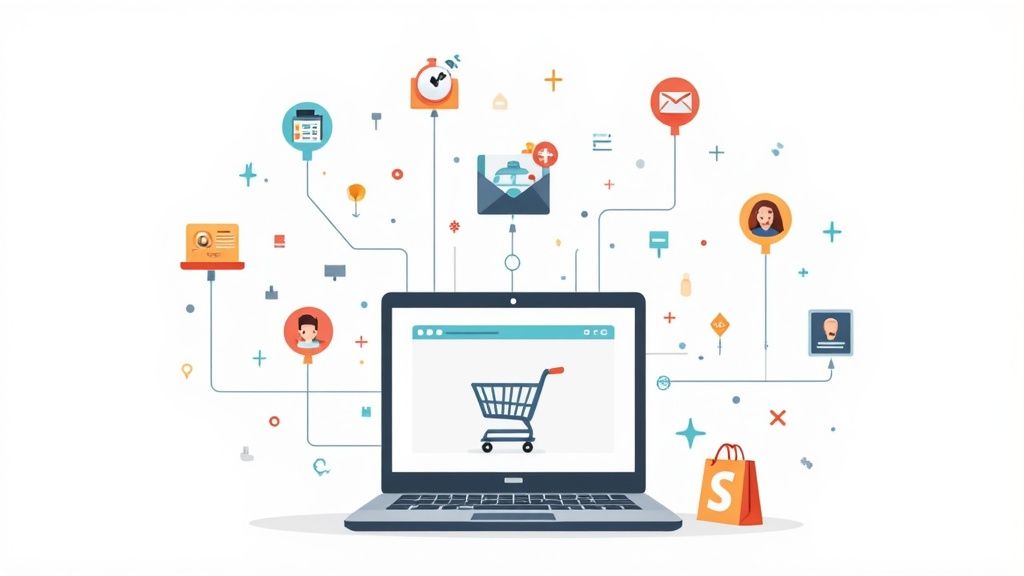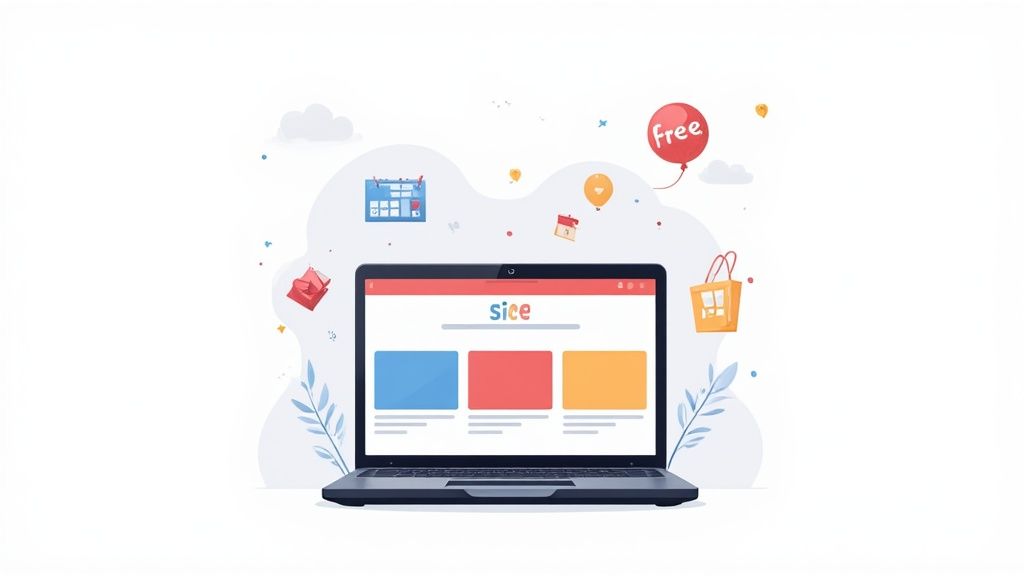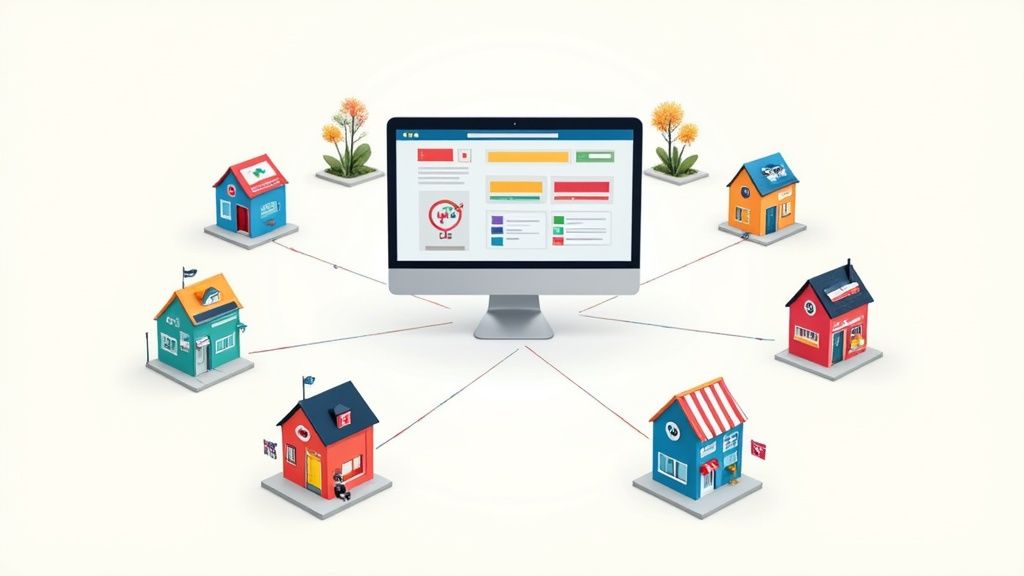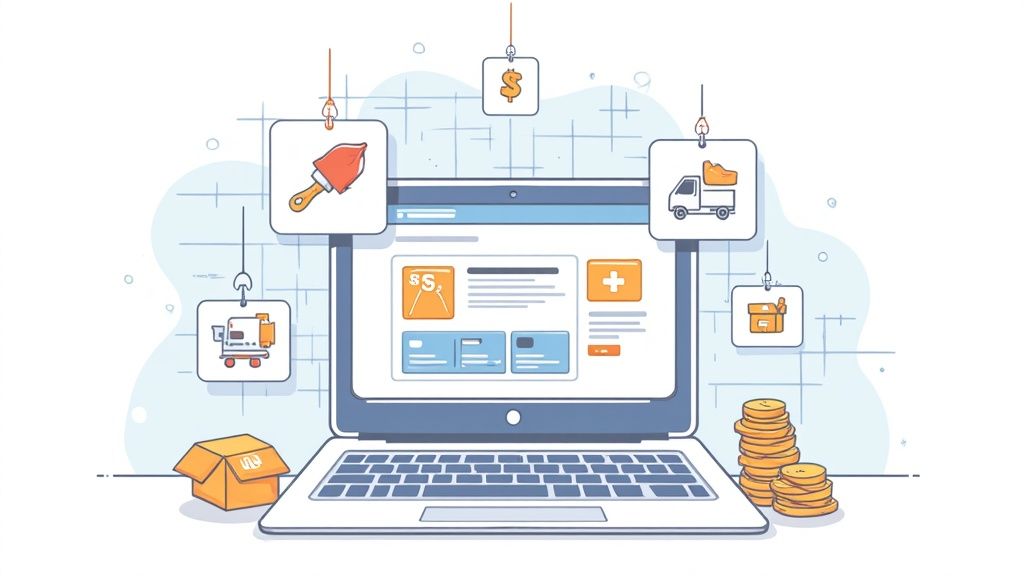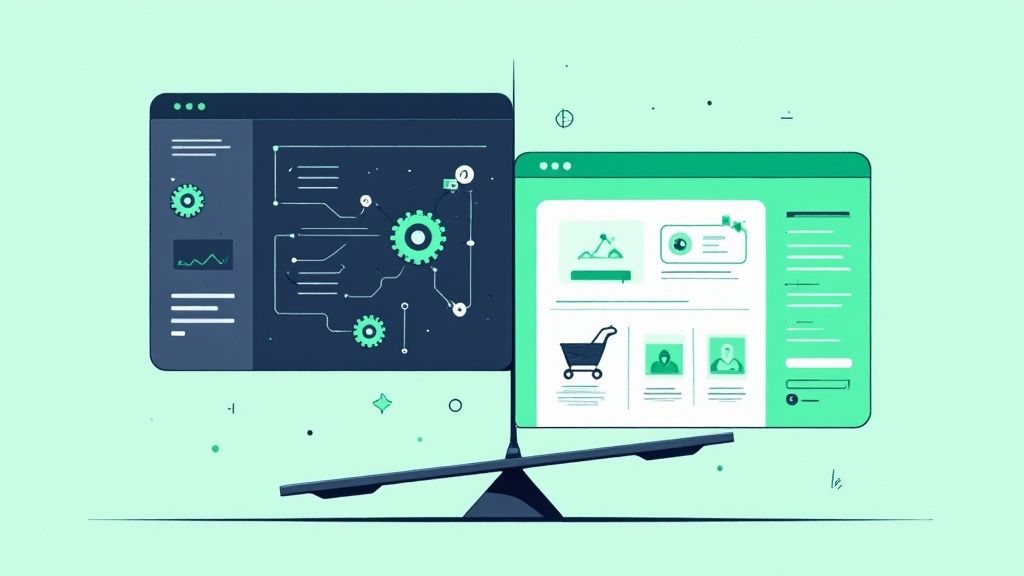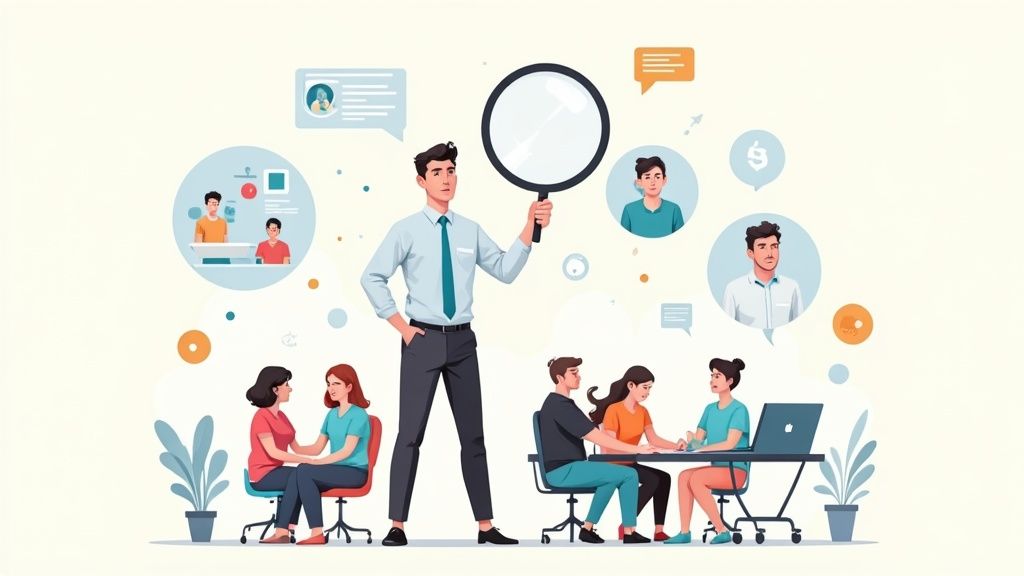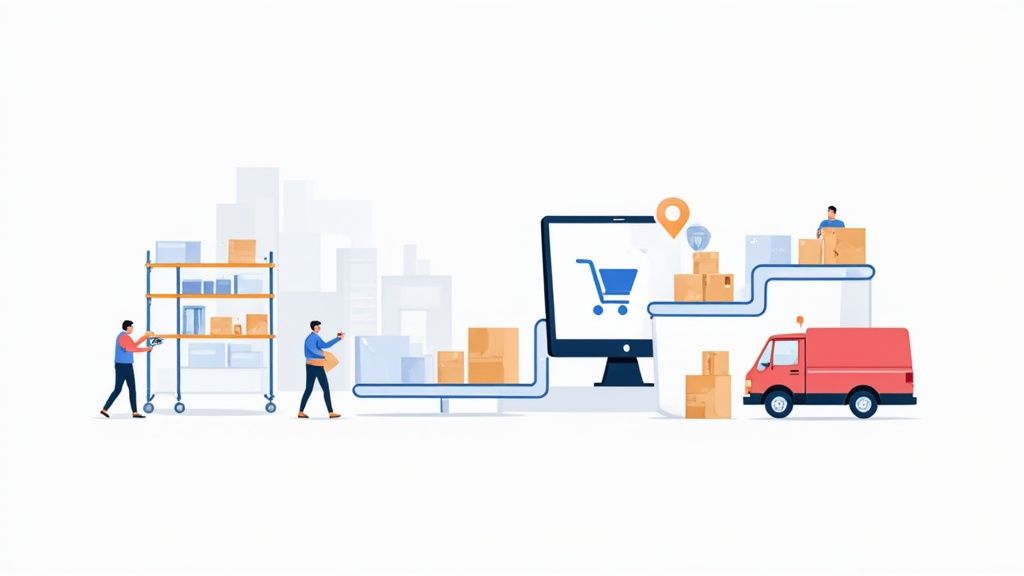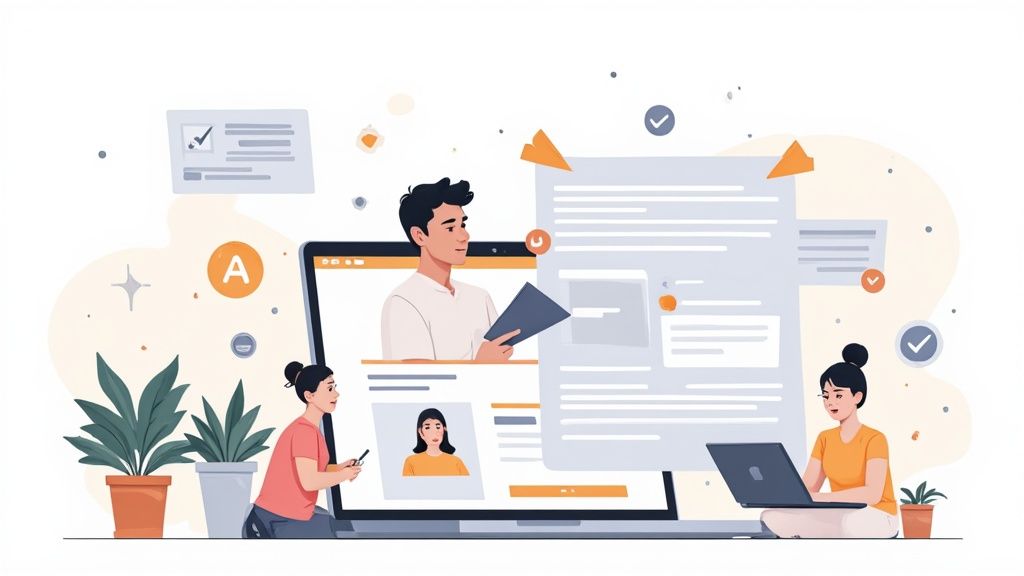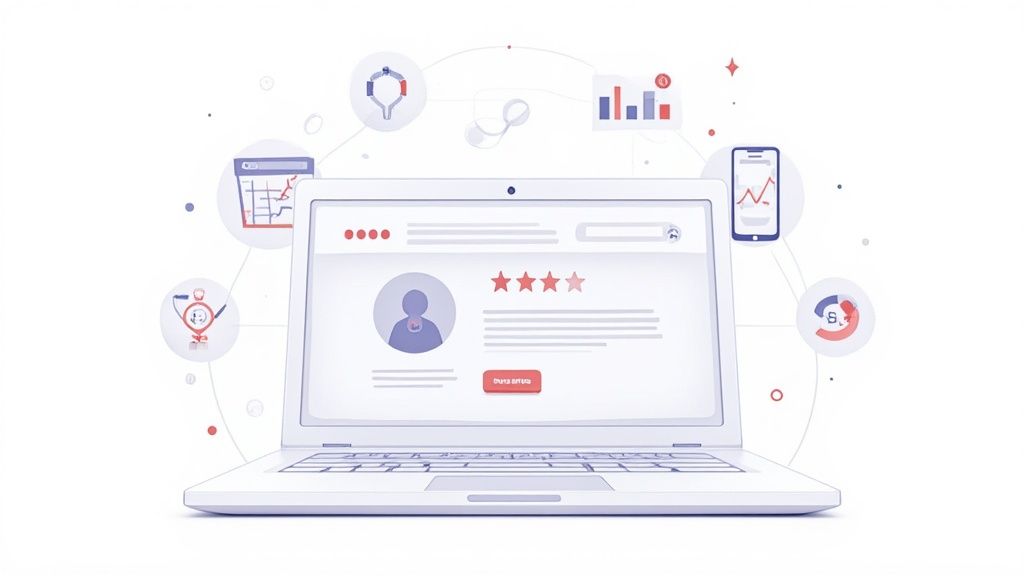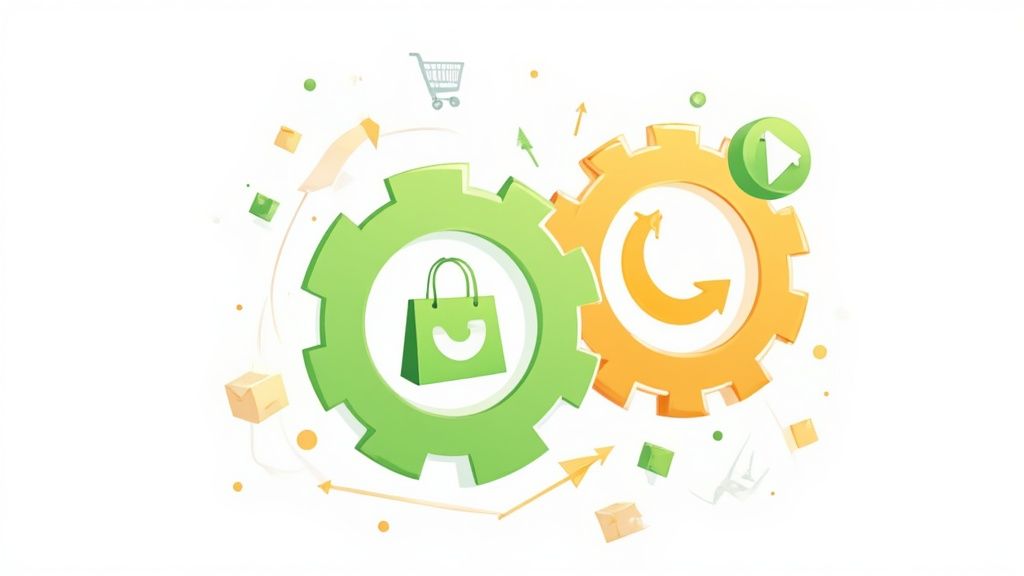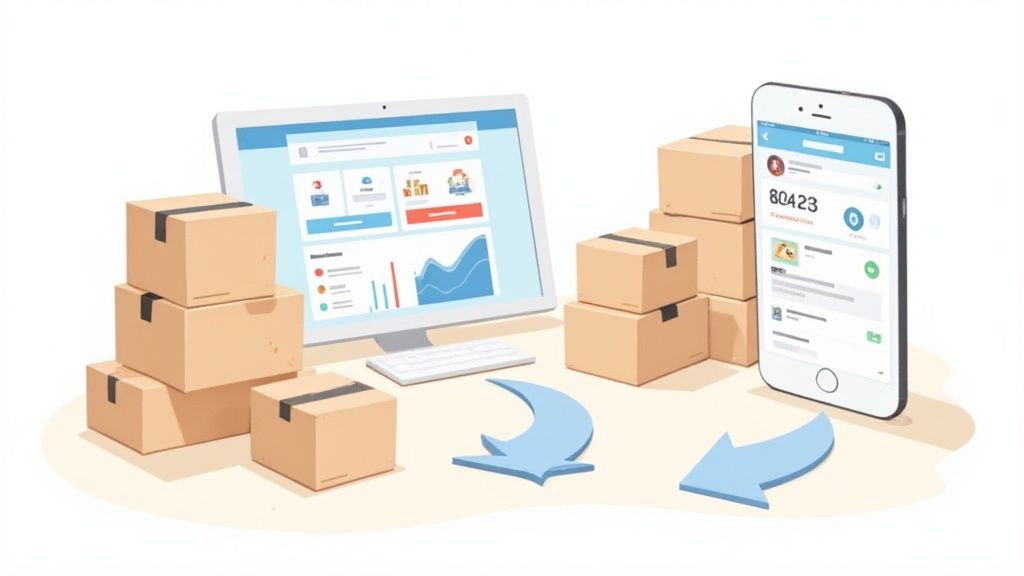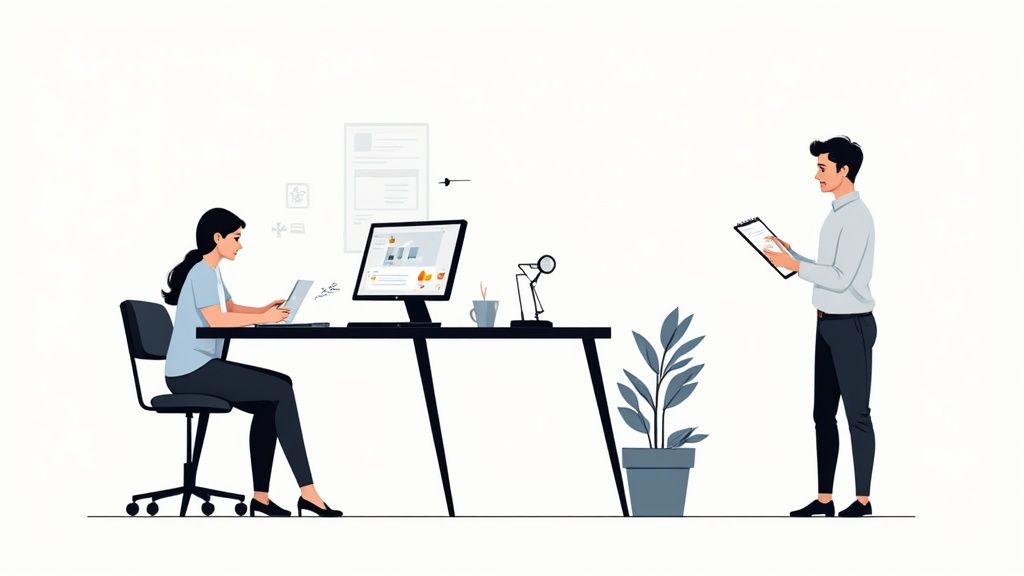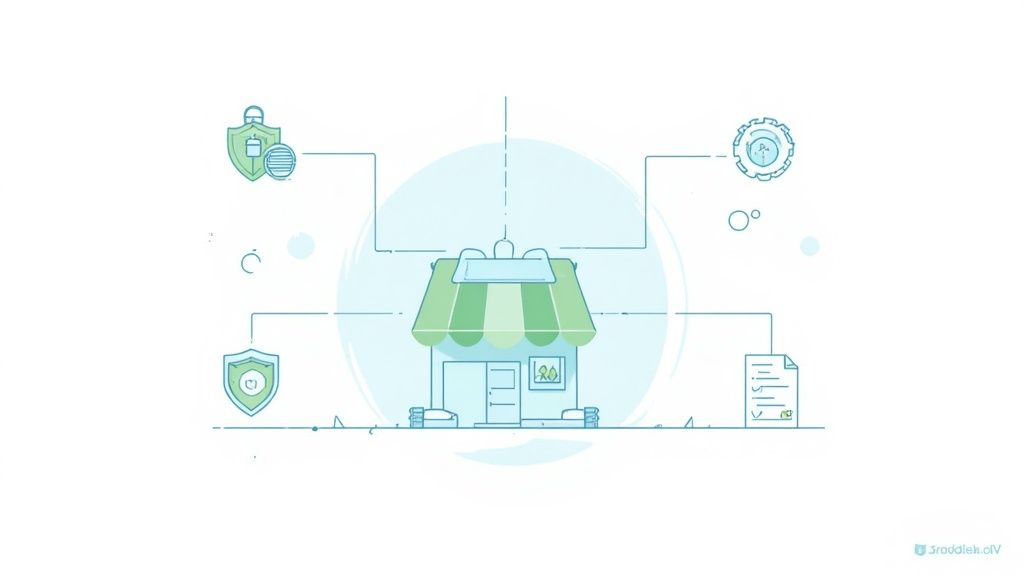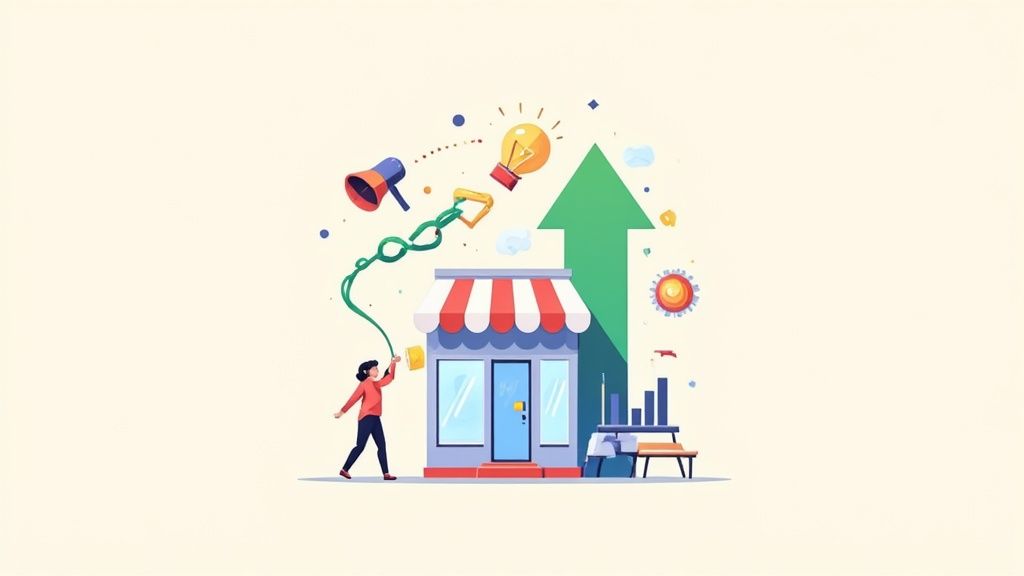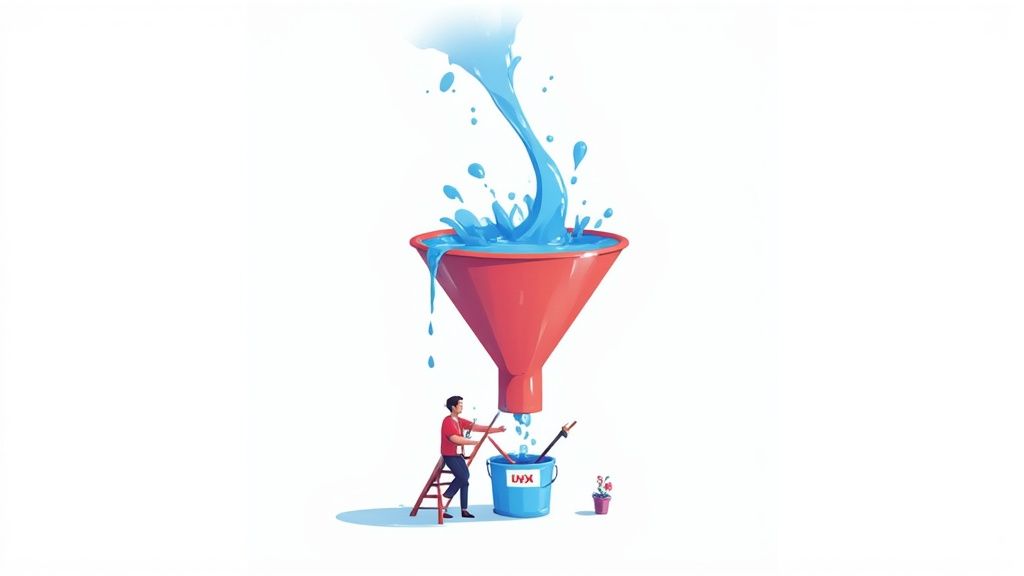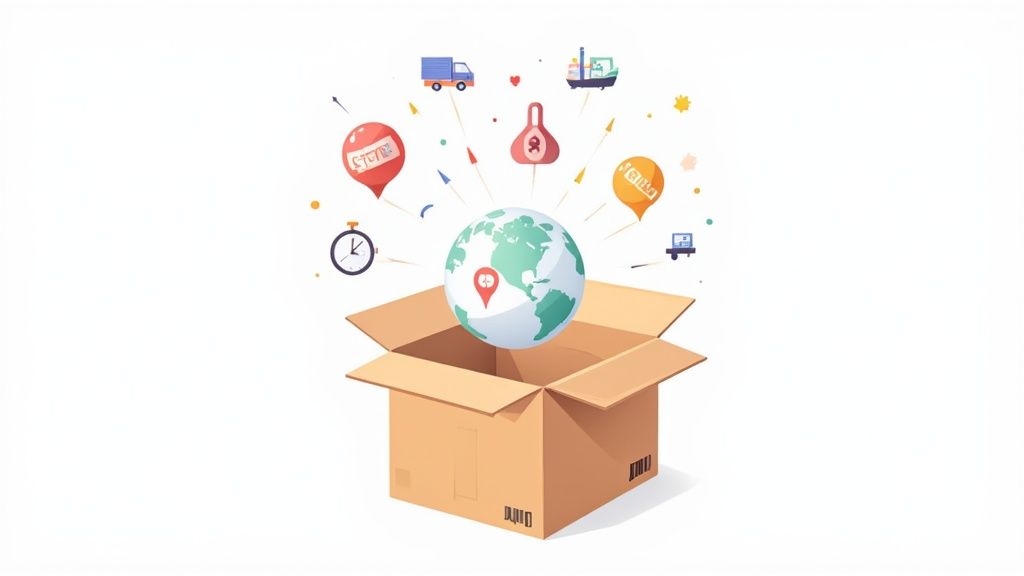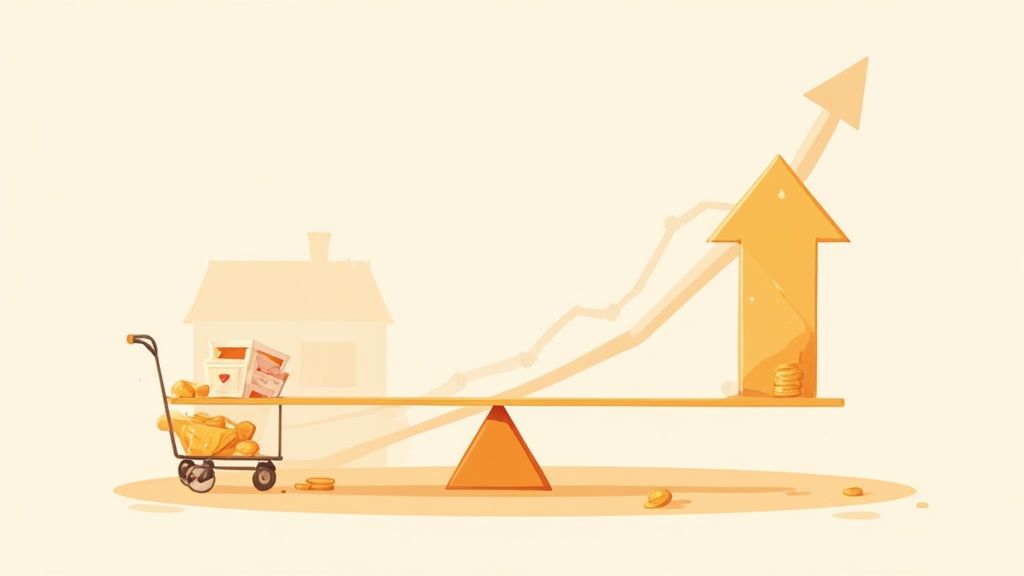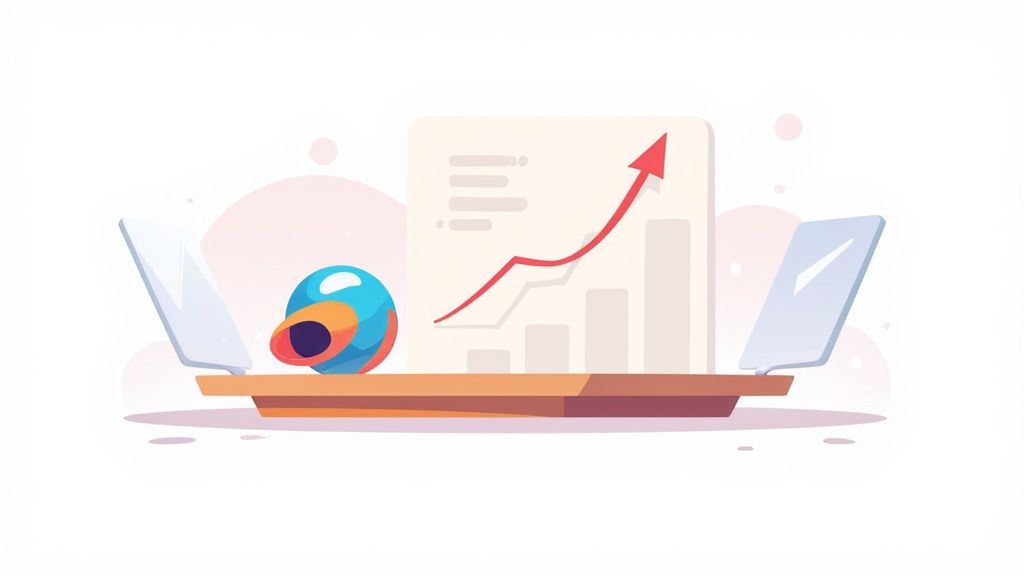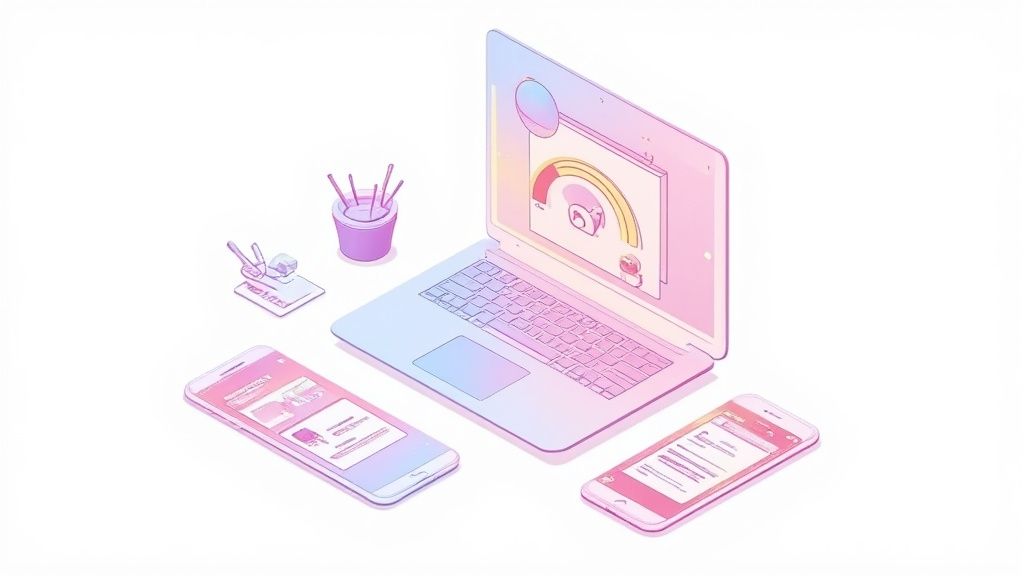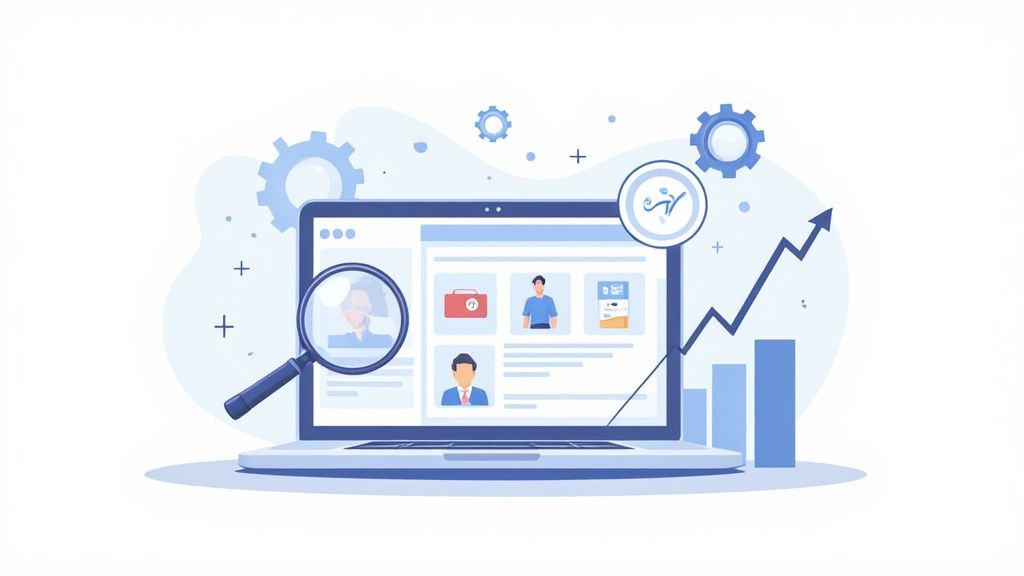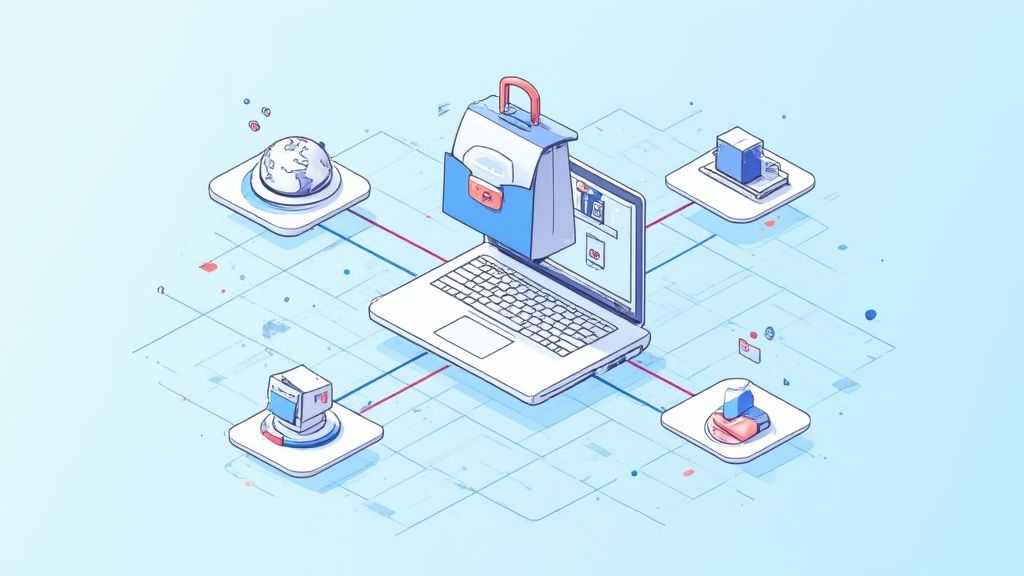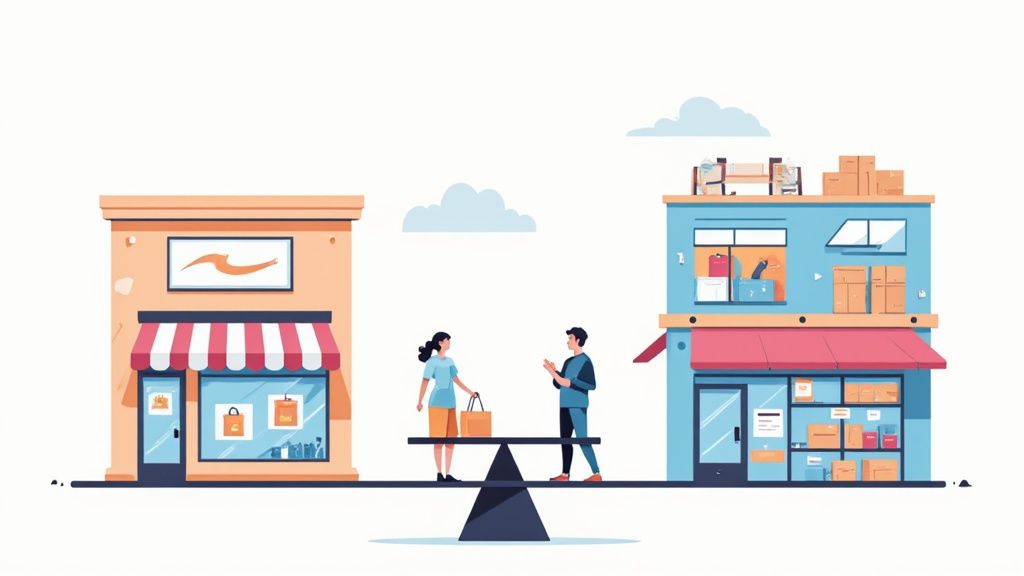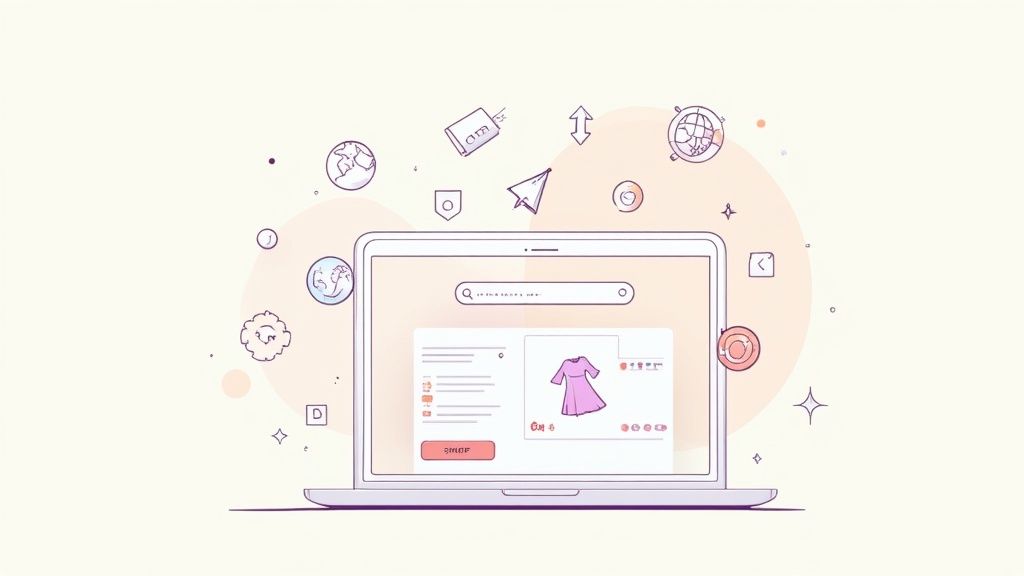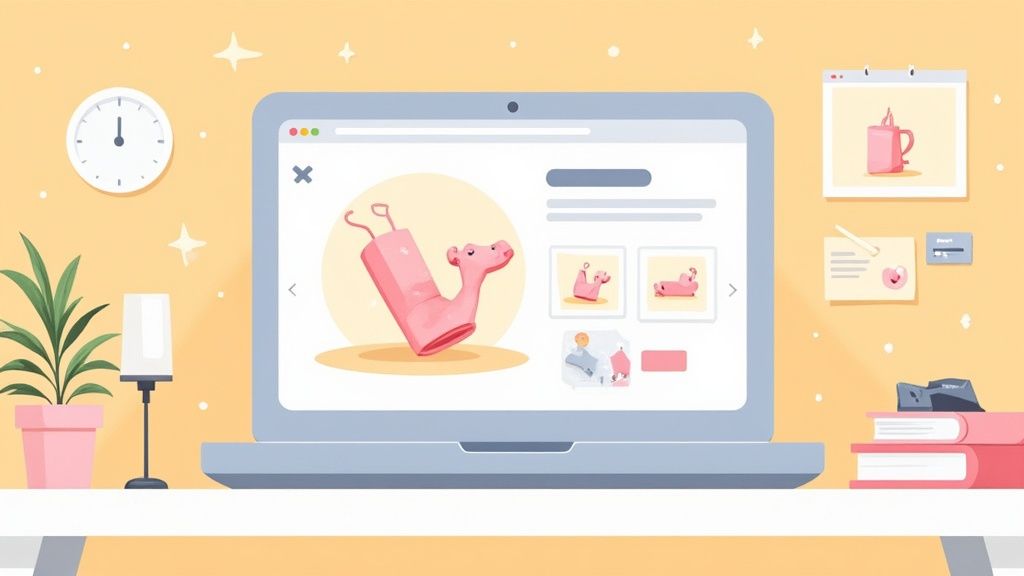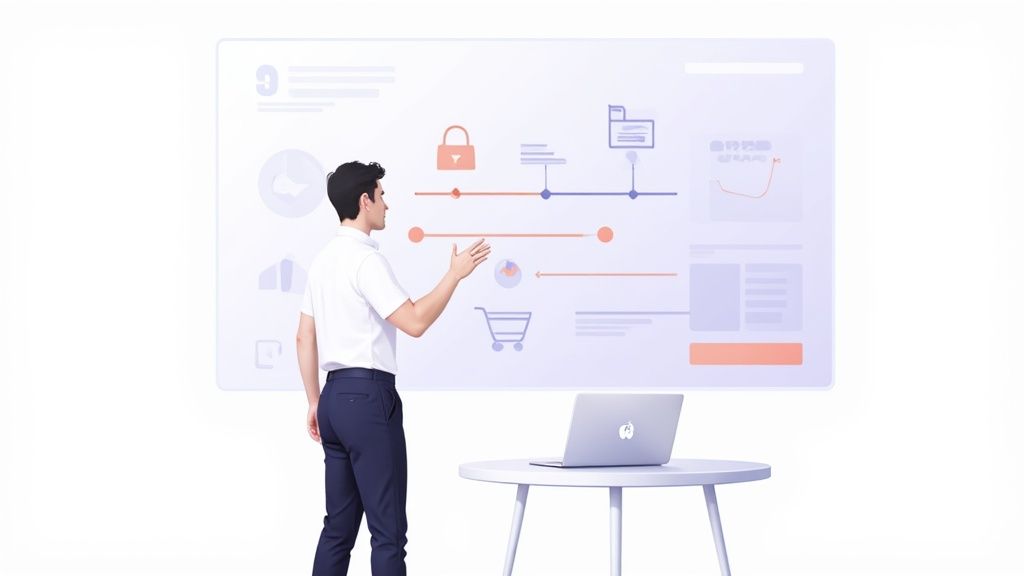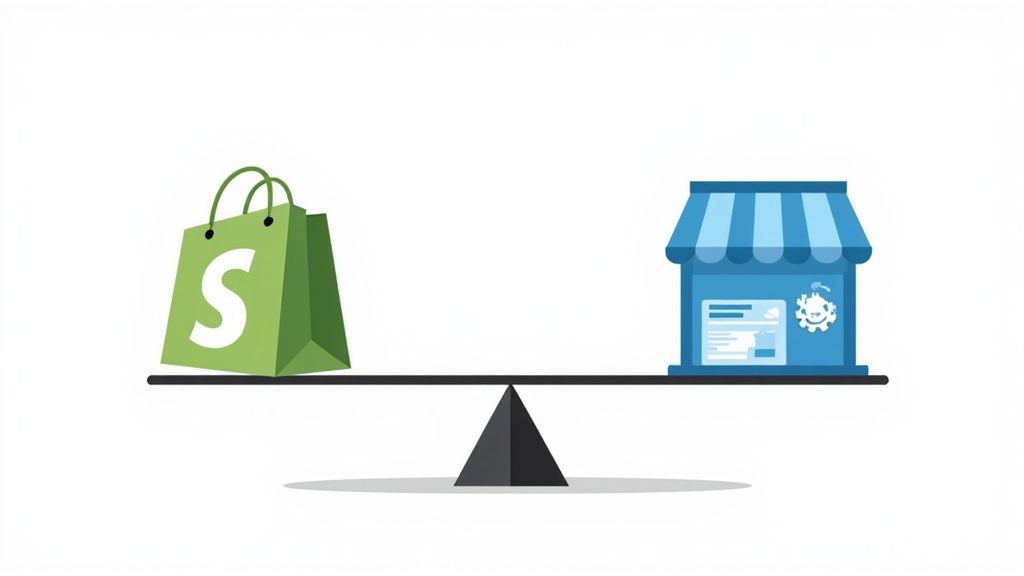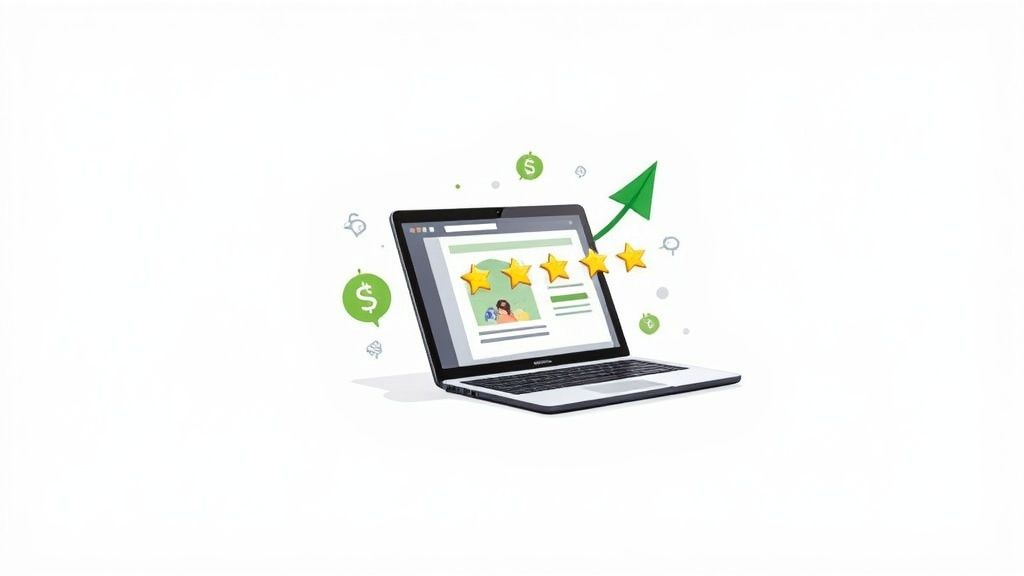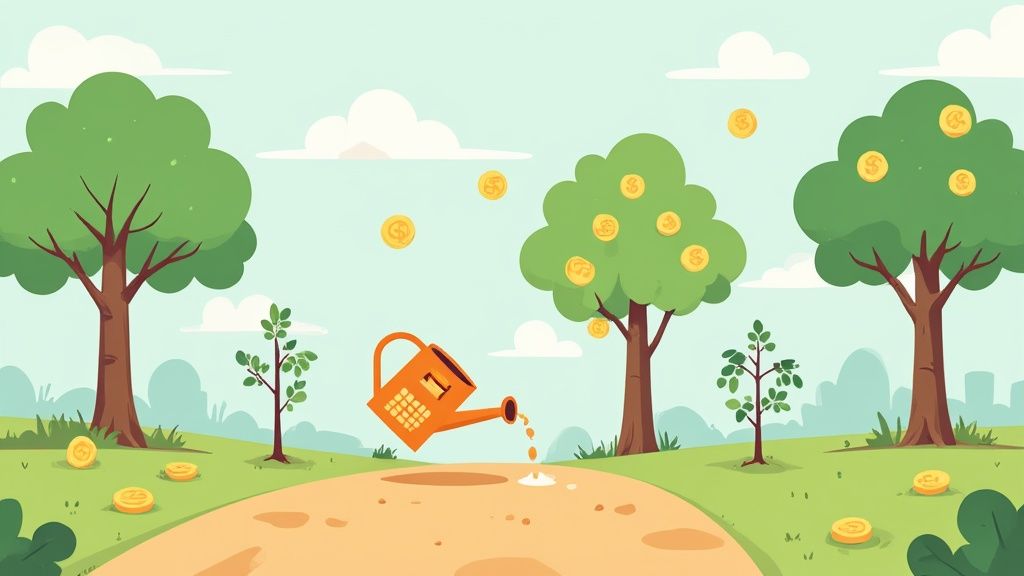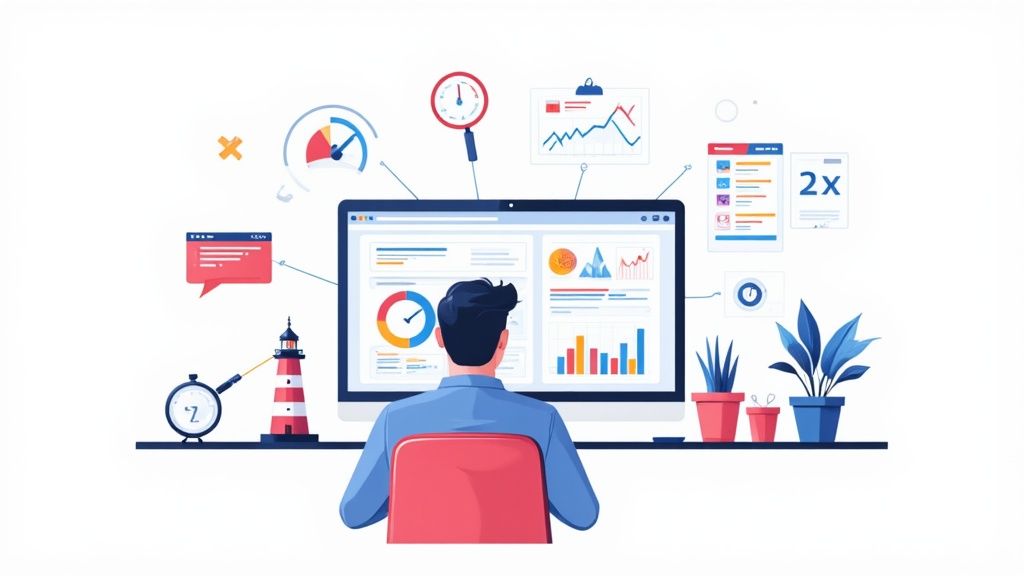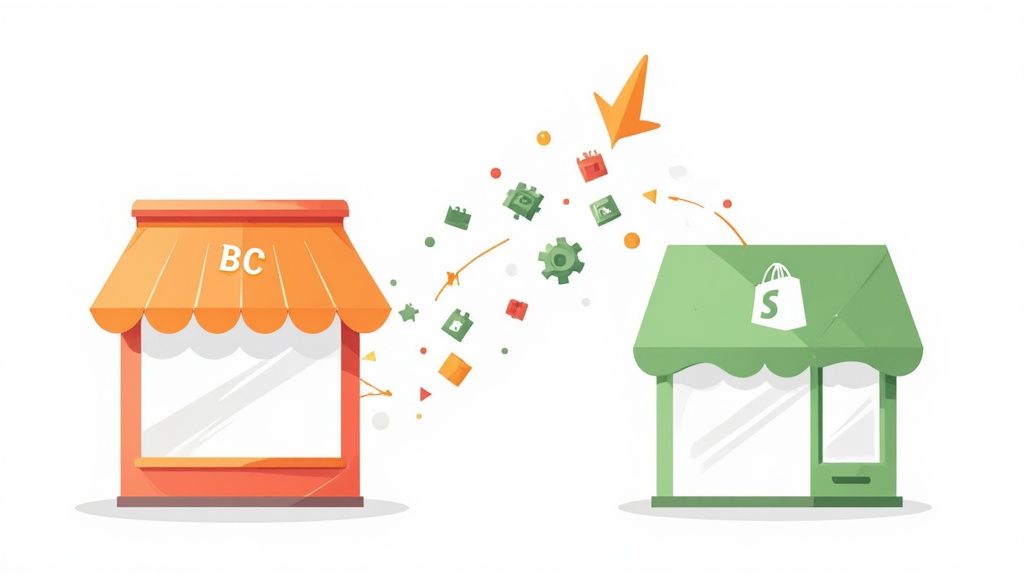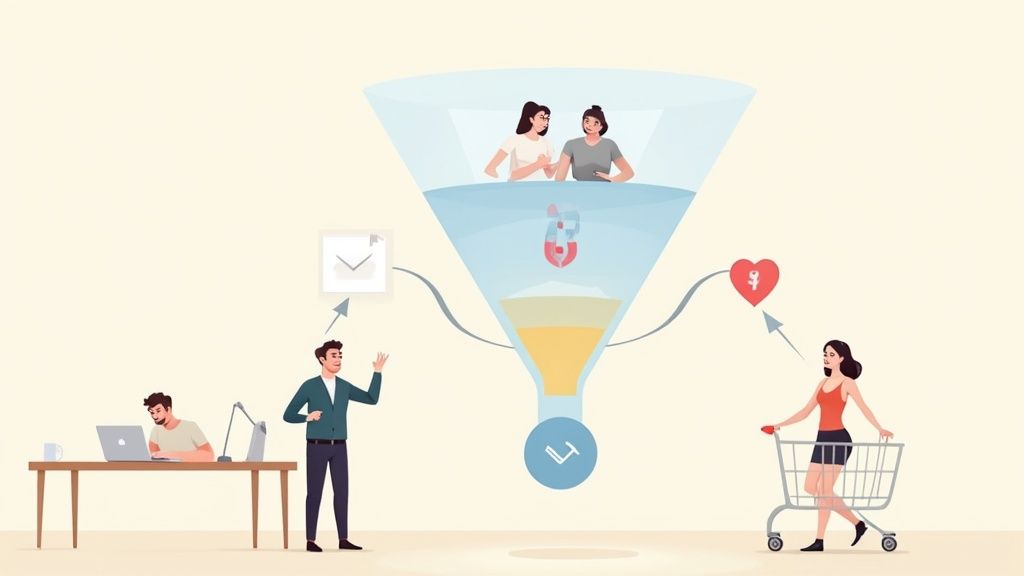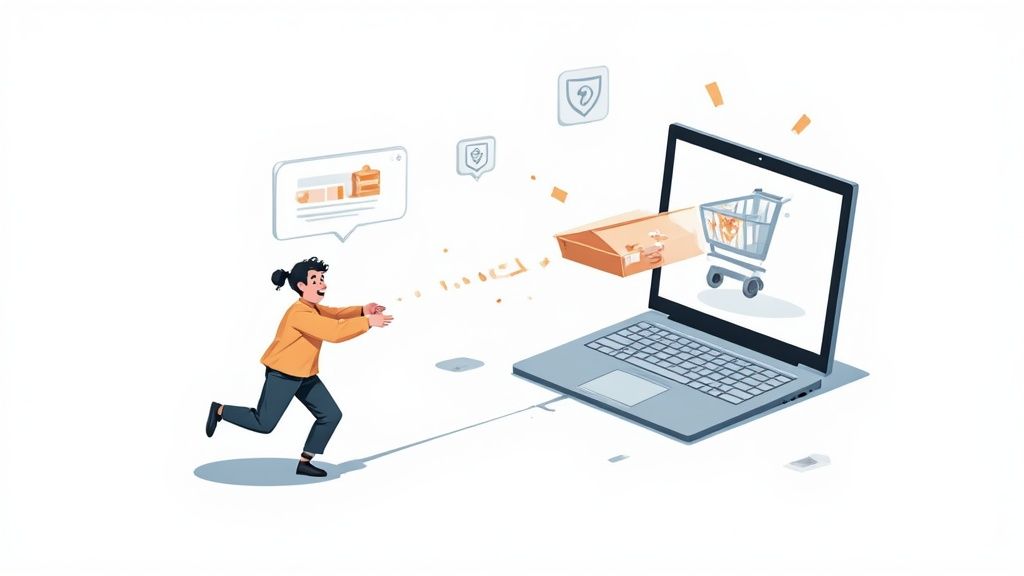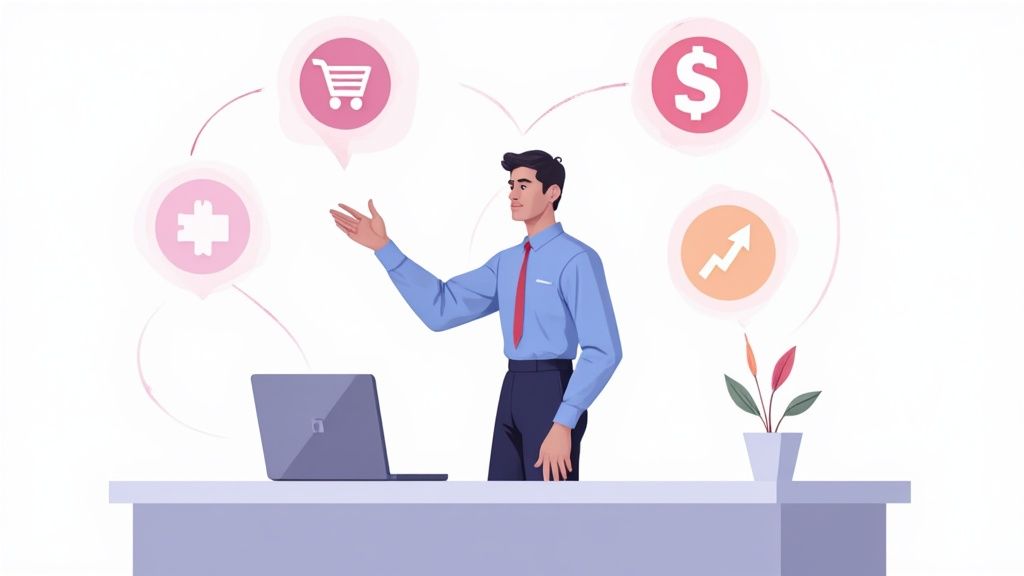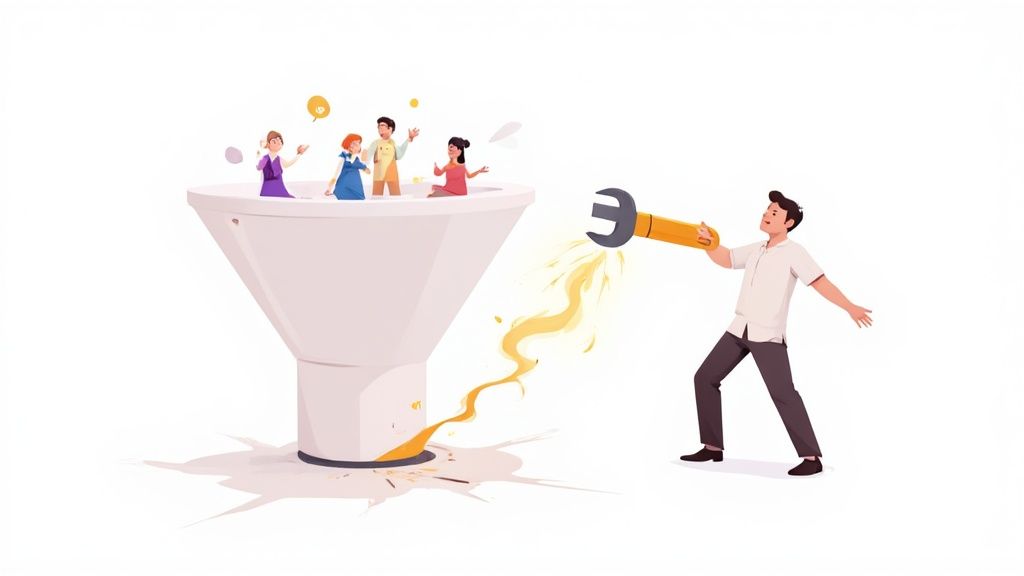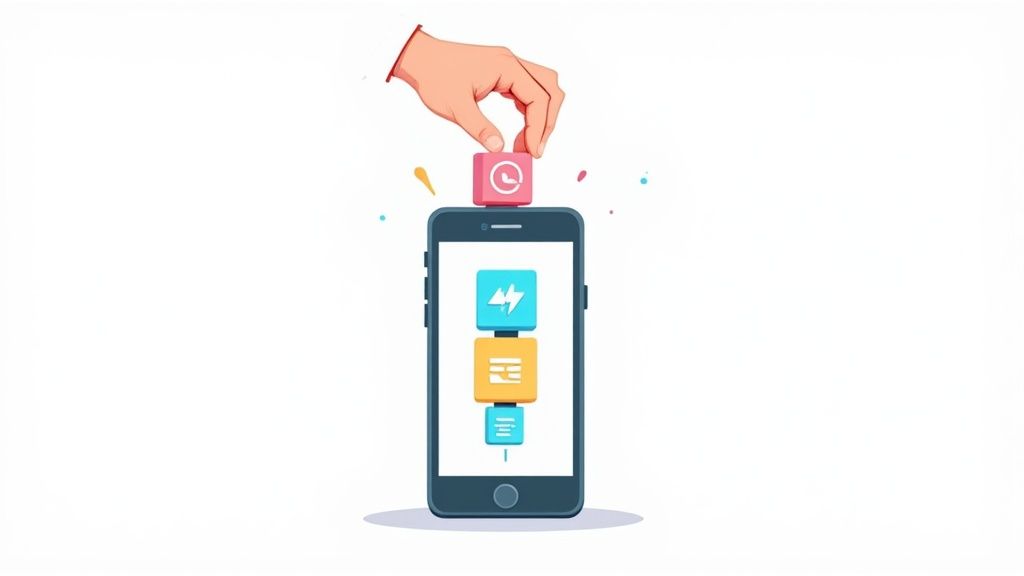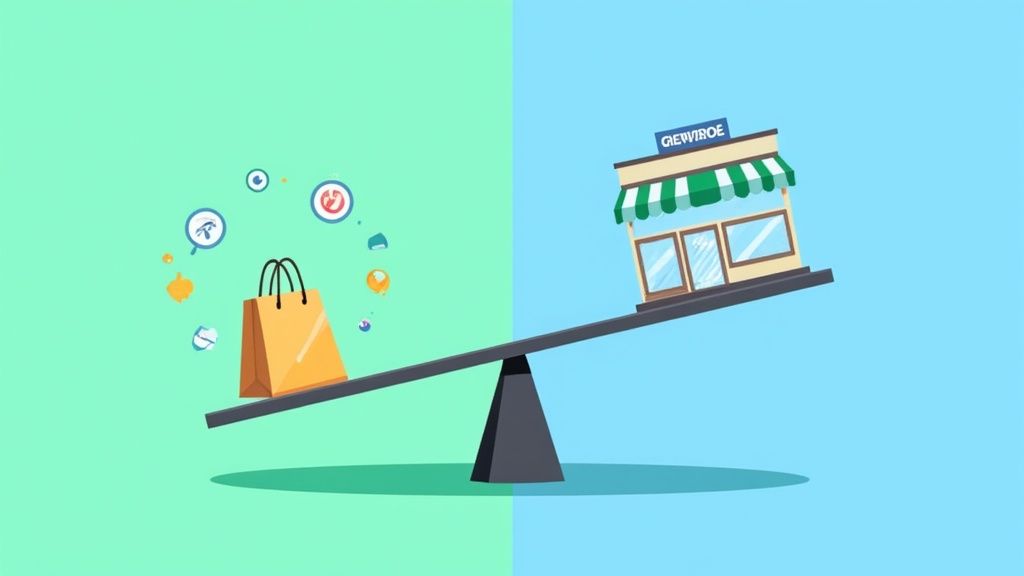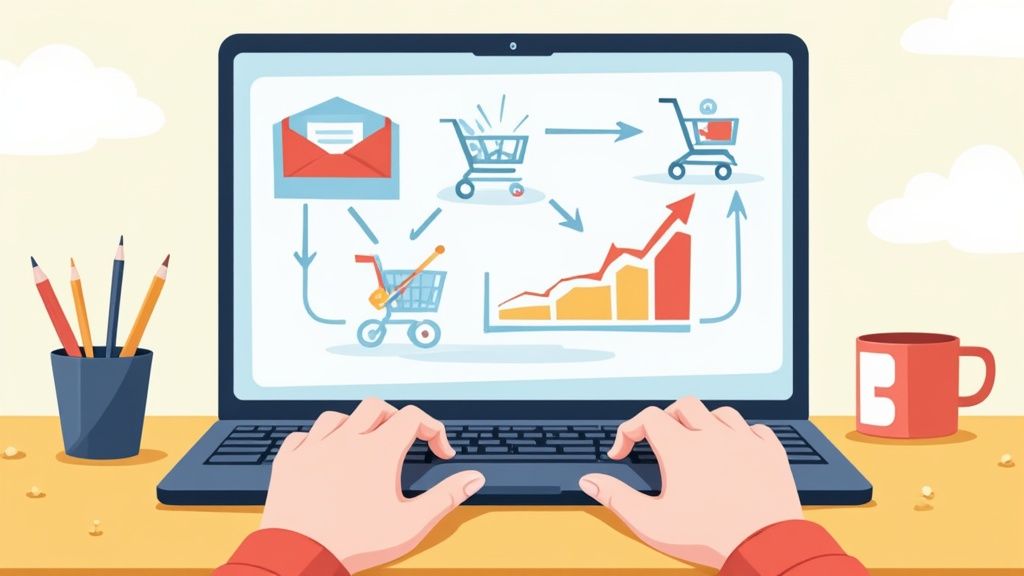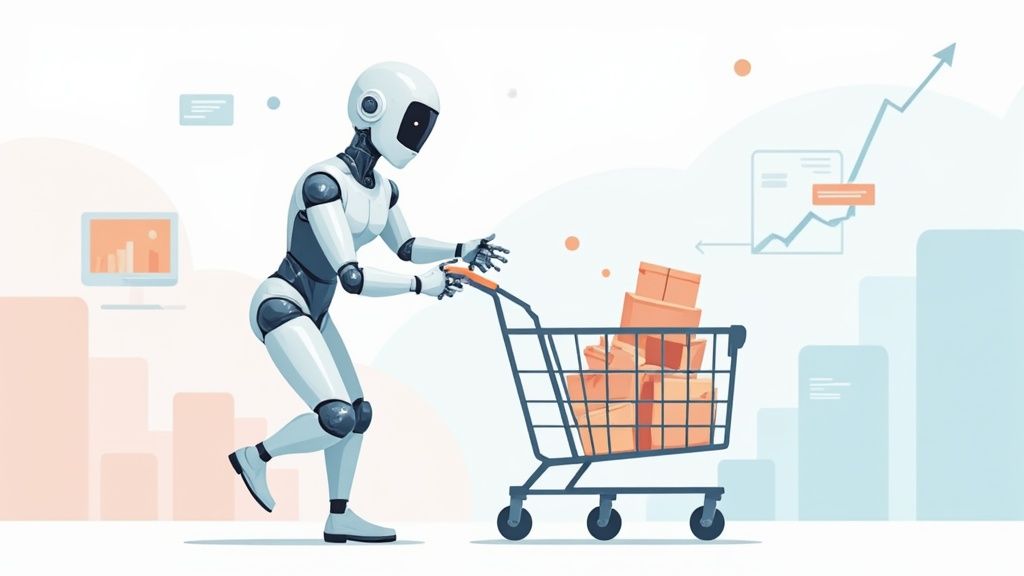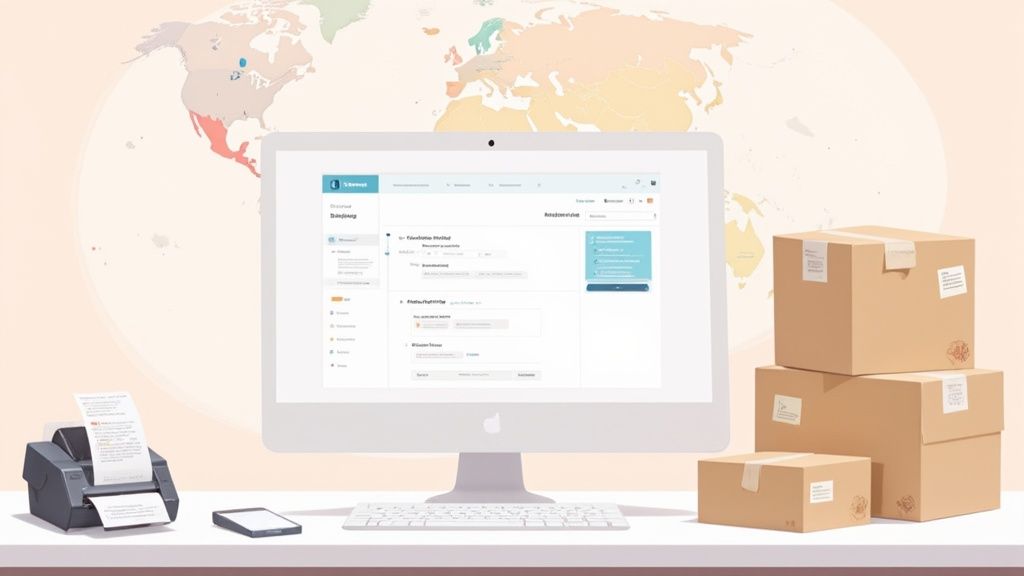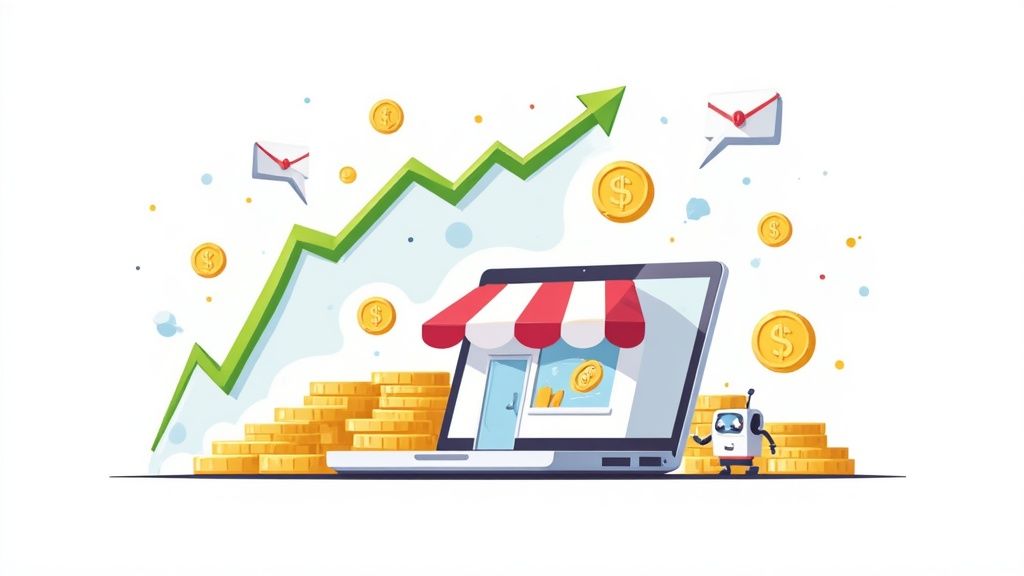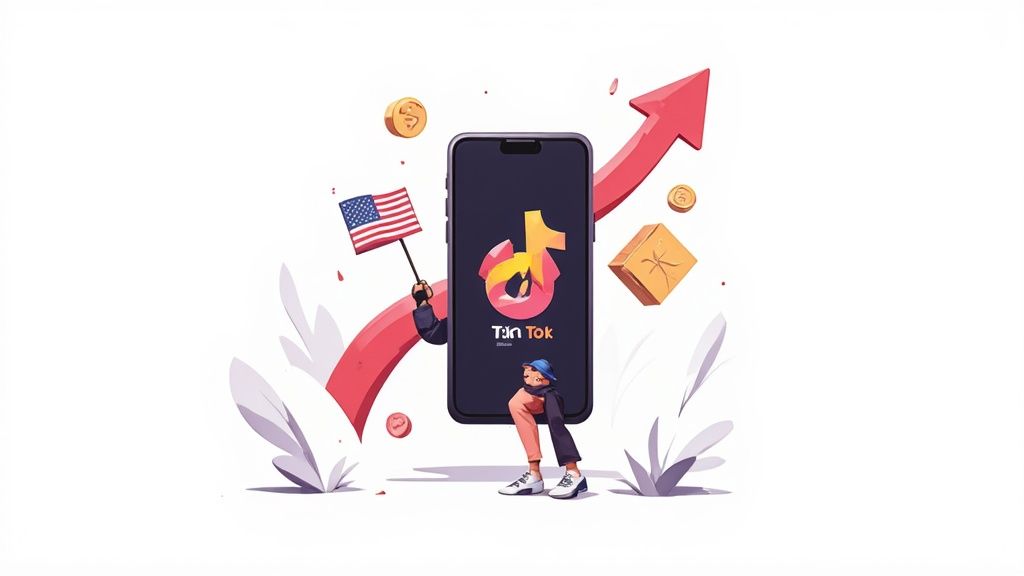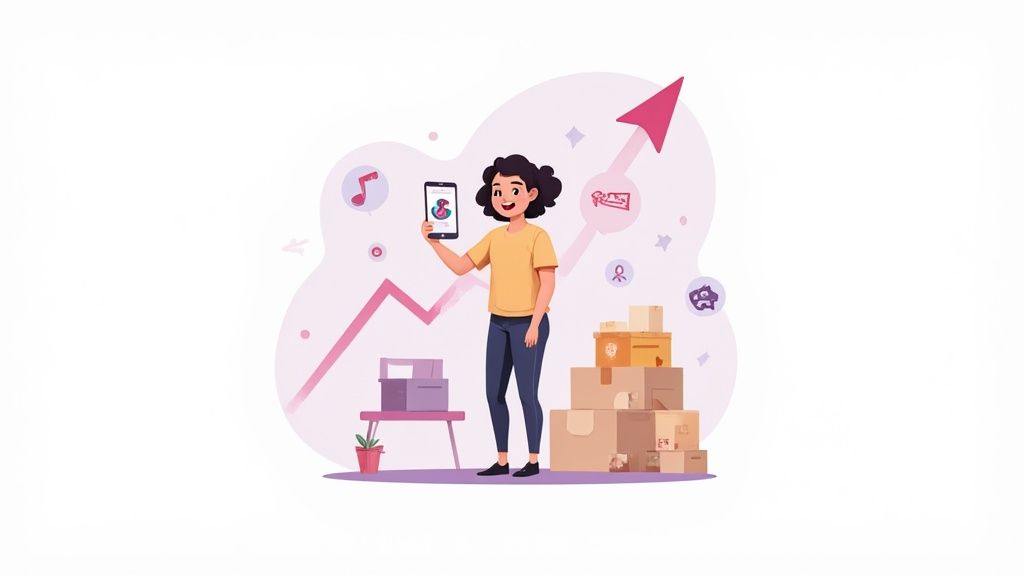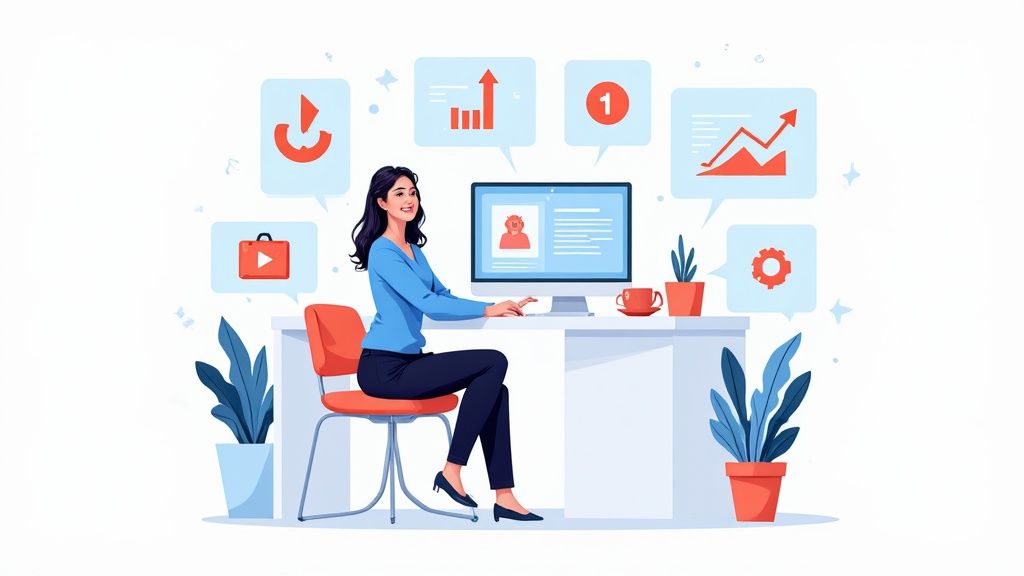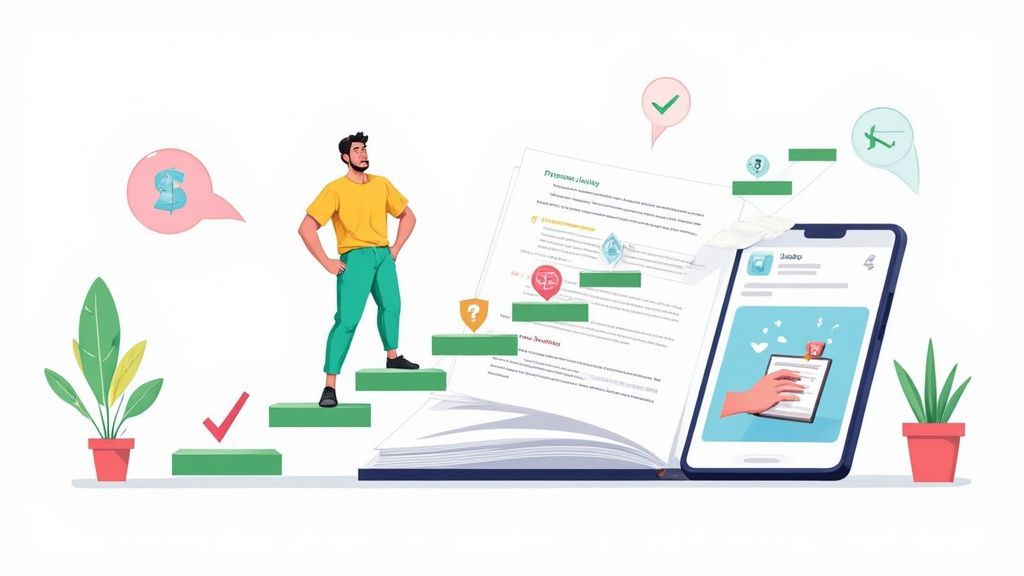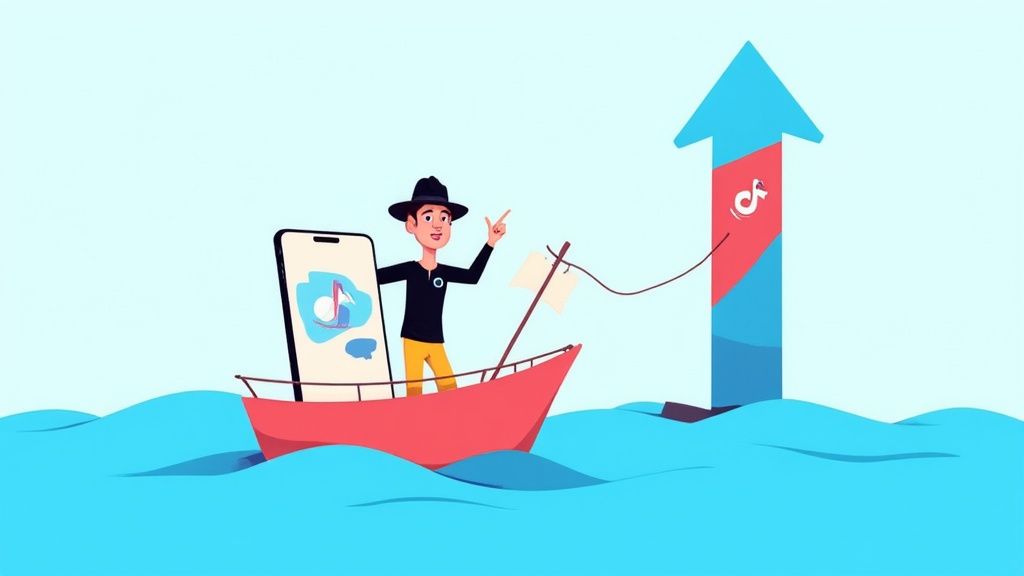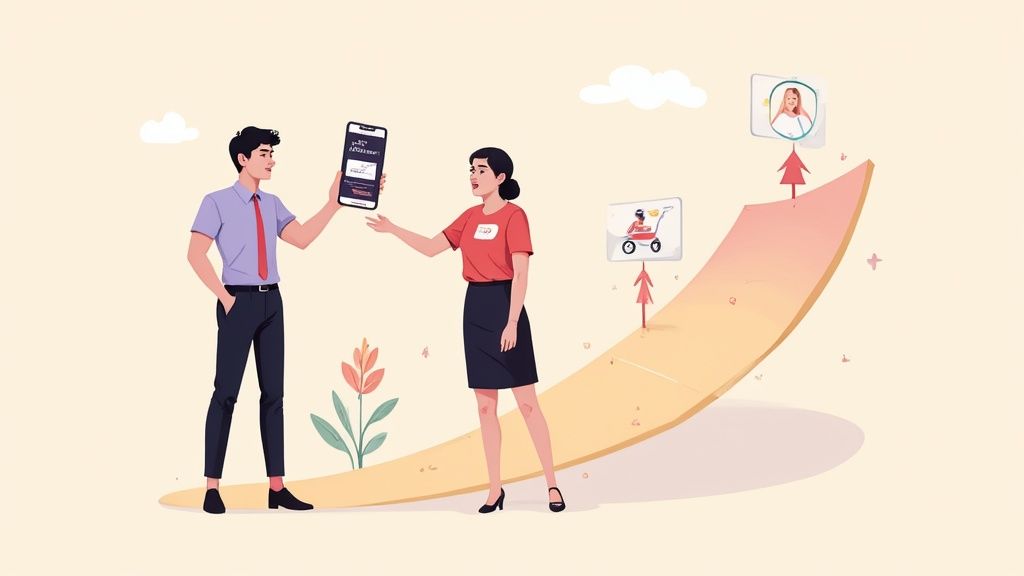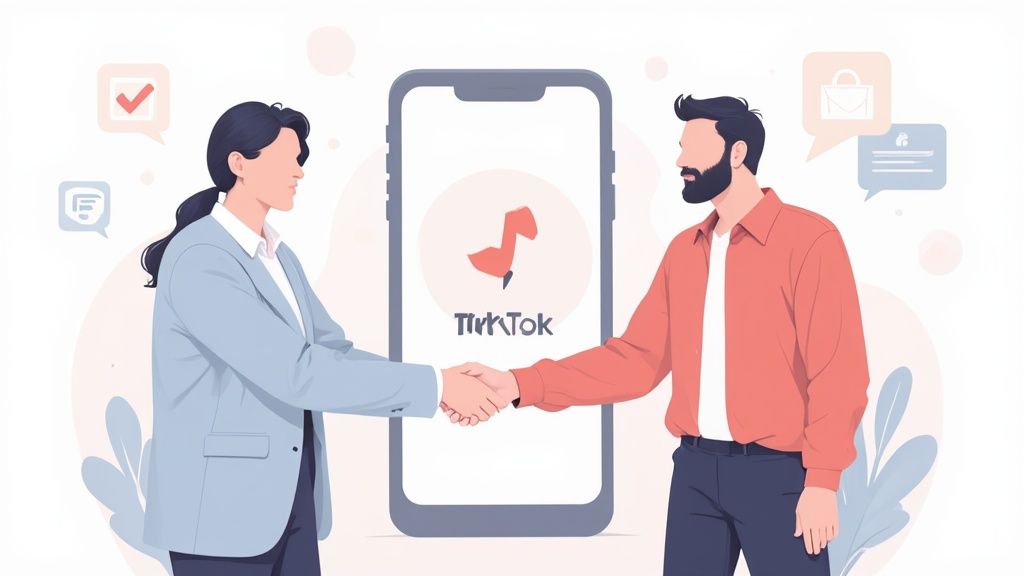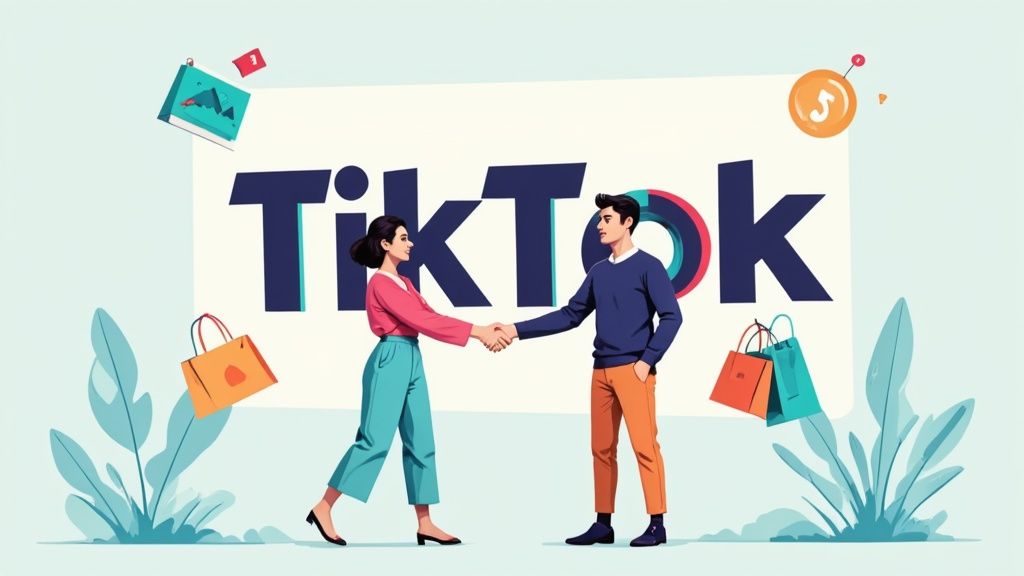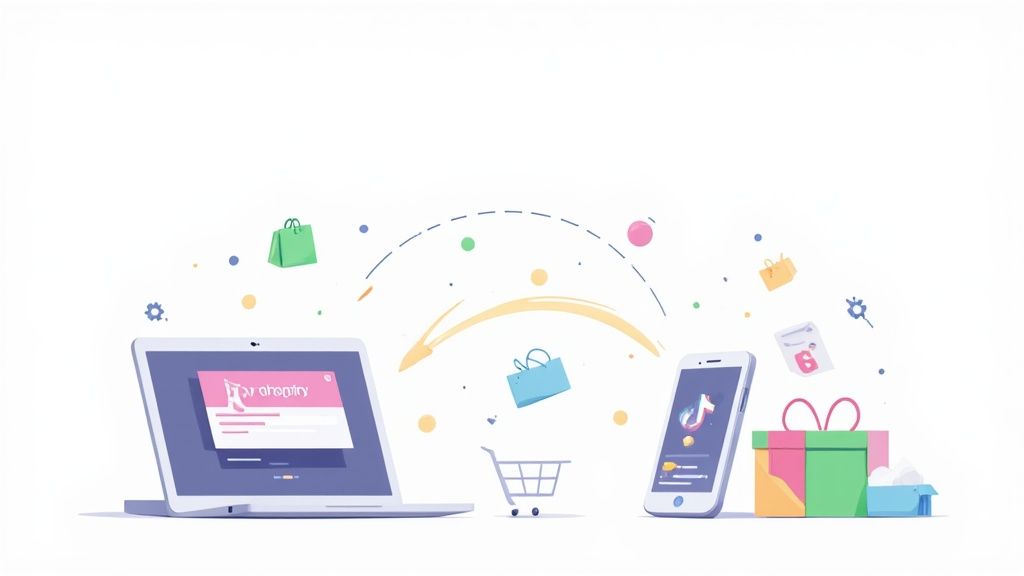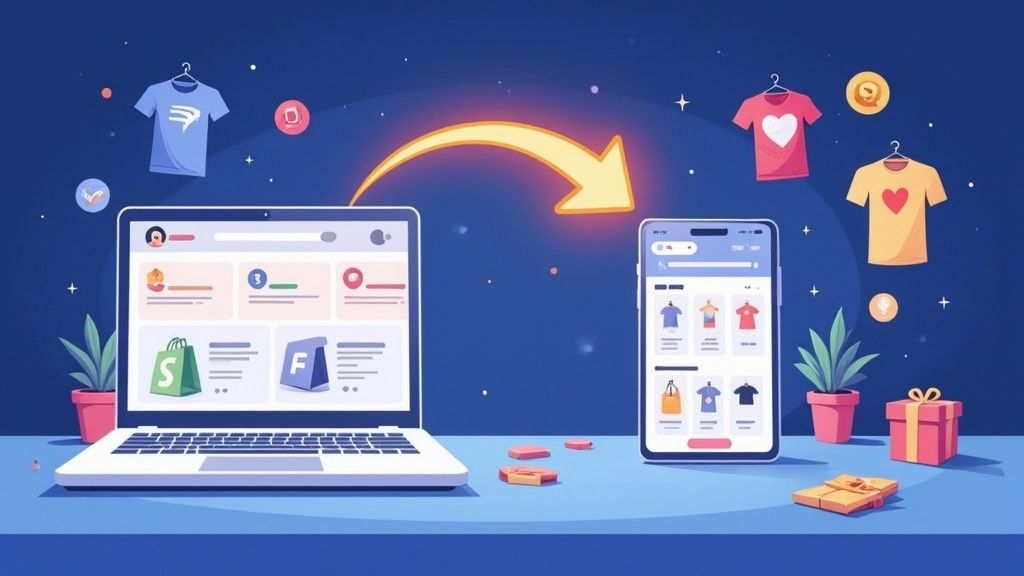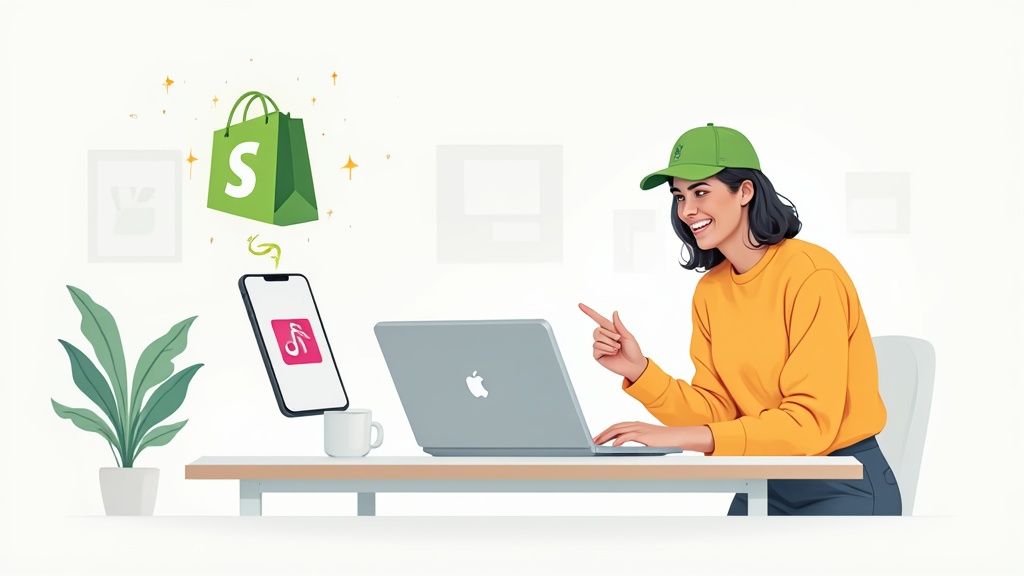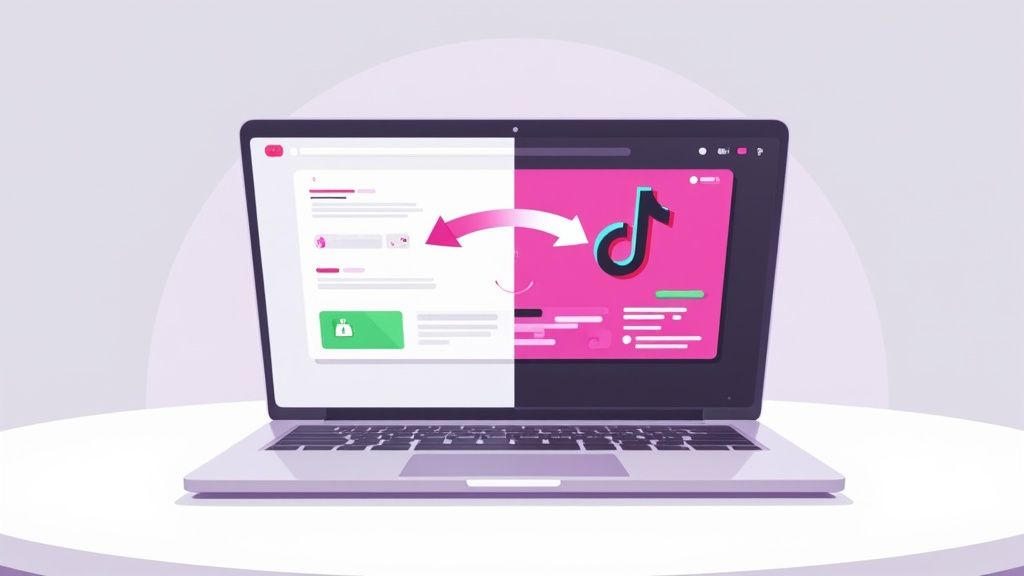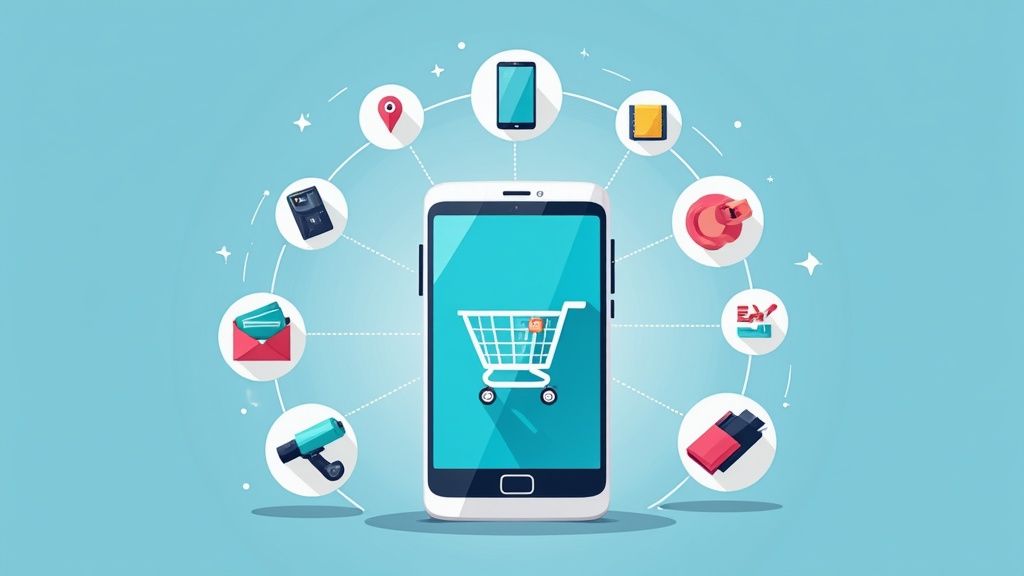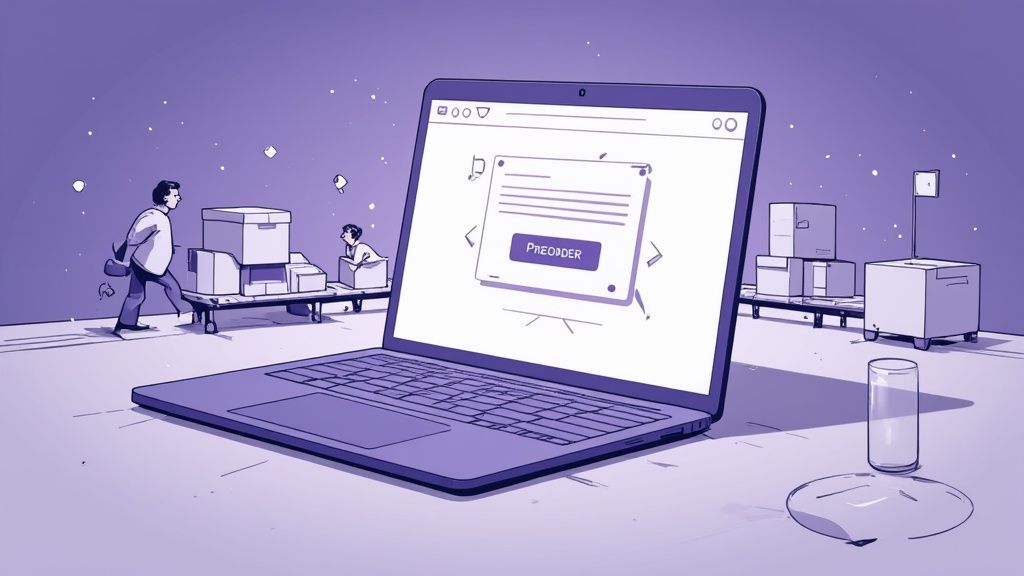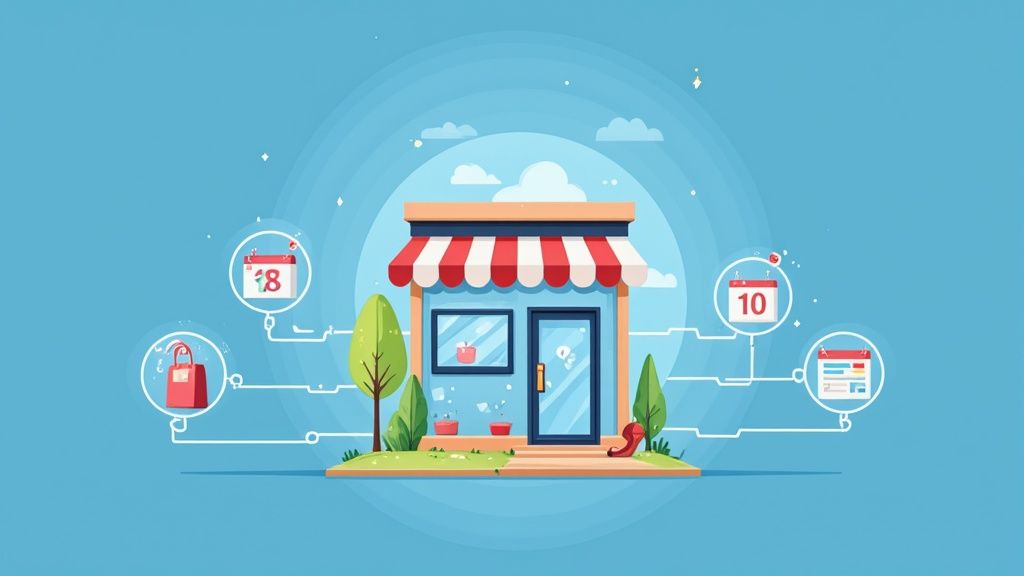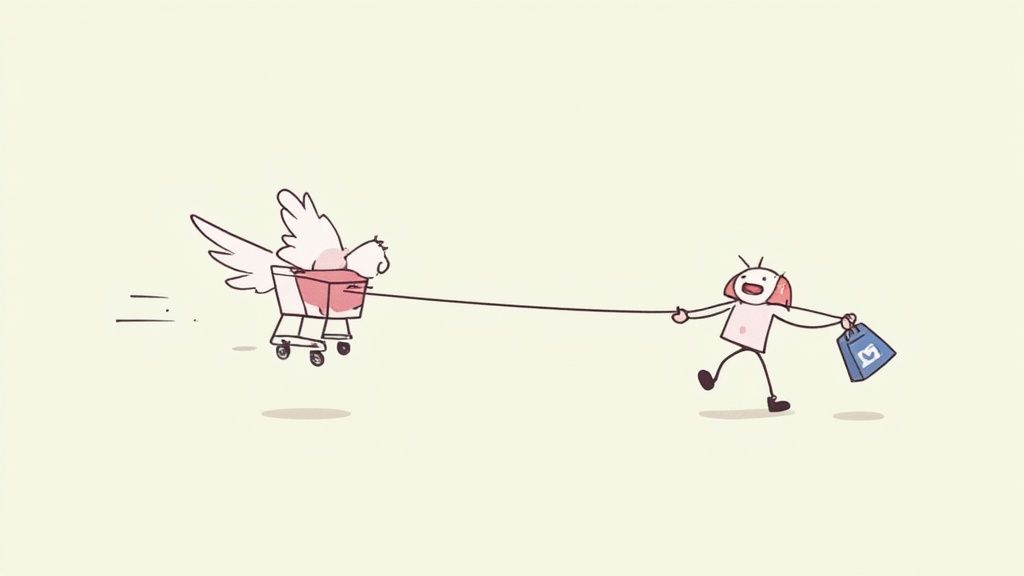
If you want to boost customer retention, you need to shift your focus from constantly chasing new leads to appreciating the customers you already have.The core idea is simple: it's far more profitable to keep a current customer than to find a new one. When you implement the right strategies, you can turn one-time buyers into loyal brand fans who fuel your store's long-term, sustainable growth.
Why Customer Retention Is Your Greatest Growth Lever

For a minute, let's forget the expensive, never-ending hunt for new customers. The real secret to sustainable ecommerce growth is already sitting in your Shopify database.
Too many brands fall into the "leaky bucket" trap—spending a fortune on marketing to attract new buyers, only to watch them vanish after a single purchase. This cycle isn't just inefficient; it's a massive drain on your finances.
Focusing on customer retention isn't just a nice-to-have; it's one of the smartest business moves you can make. It’s about building genuine relationships, not just processing transactions. When you neglect your existing customers, you're signing up for a constant, expensive battle for profitability.
The Financial Drain of Customer Churn
Customer churn is a silent profit killer. The numbers are frankly staggering—U.S. businesses are on track to lose an estimated $168 billion annually by 2025 simply because customers walk away.
This problem is especially bad in competitive industries like hospitality and travel, where retention rates have dropped to just 55%. These sectors are dealing with a perfect storm of fierce competition, wild swings in demand, and sky-high customer expectations. And it's not just a problem for hotels and airlines; it's a huge challenge for Shopify stores of all sizes.
Every lost customer means more than just one missed sale. It represents the loss of all the potential future revenue that person could have brought to your business.
Why a Loyal Customer Is So Much More Valuable
The business case for retention gets even stronger when you look at the upside. A loyal customer is exponentially more valuable than a new one. Here’s why:
- Higher Average Order Value (AOV): Repeat buyers already trust your brand. They're much more willing to spend more with each purchase over time.
- Increased Purchase Frequency: Loyal customers come back more often, creating a predictable and stable revenue stream you can count on.
- Powerful Word-of-Mouth Marketing: Happy customers become your best (and most authentic) brand ambassadors, driving organic growth without you spending an extra dime.
A mere 5% improvement in customer retention can boost a company's profitability by 25% to 95%. This just goes to show that keeping customers is one of the most powerful growth strategies out there.
This table highlights the core financial and strategic benefits of prioritizing customer retention, giving you a quick snapshot of the key arguments discussed in this section.
The Financial Upside of Customer Retention
Focusing on appreciation over pure acquisition isn't just a feel-good tactic; it's a direct path to a healthier business. Every interaction after that first sale is a chance to build loyalty and prove your brand’s value. To dig deeper into what works, you can explore a comprehensive list of customer retention best practices. By investing in the customers you already have, you build a resilient business that can thrive in any market.
Design Loyalty Programs That Inspire True Devotion

Let's be honest: a lot of loyalty programs are just glorified discount clubs. They feel transactional, offering points for cash in a way that does little to build a real relationship. If you want to actually increase customer retention, you need to build something that creates a genuine emotional investment in your brand. It’s about moving beyond the simple points-for-purchases model and creating an experience that feels exclusive, valuable, and uniquely you.
When done right, a great program turns casual shoppers into die-hard brand advocates. The numbers don't lie. Research consistently shows that 80% of a company’s future profits will come from just 20% of its existing customers. That's the power of loyalty right there. The goal is to make your customers feel like they're part of an inner circle—a community they’re proud to belong to.
The secret is to structure a system that feels like a natural part of your brand, not some generic plugin you just switched on. It should celebrate the relationship, not just the transaction.
Go Beyond Basic Points
The old "spend more, save more" model only goes so far. Sure, everyone appreciates a discount, but that alone doesn't build deep-seated loyalty. To create something truly memorable, you need to mix monetary rewards with non-monetary perks that align with your customers' values and aspirations.
A tiered system is a fantastic place to start. It’s psychologically effective because it taps into our natural desire for status and achievement. Customers see a clear path to bigger and better rewards, which gives them a real reason to engage more often.
Here’s a simple breakdown of what that could look like:
- Bronze Tier (Entry-Level): A customer might unlock this just by creating an account. Think small welcome bonus, early access to blog posts, or a little something for their birthday.
- Silver Tier (Engaged Customer): After a few purchases, they level up. This could mean a better points-earning rate, free shipping on certain orders, or access to a members-only Facebook group.
- Gold Tier (VIP/Advocate): This is for your absolute biggest fans. We're talking exclusive access to new products before anyone else, invites to special online events, or maybe even a personal thank-you note from the founder.
This kind of structure gamifies the shopping experience, turning a simple purchase into a rewarding journey.
Weave in Non-Monetary and Community Perks
This is where the magic really happens. The most powerful loyalty programs make customers feel special in ways money can't buy. These experiential and community-driven rewards are what forge the strongest emotional connections.
For example, a skincare brand could offer its top-tier members a free one-on-one virtual consultation with a product expert. A sustainable fashion brand might let its most loyal customers vote on which charity the company supports next month. Perks like these show you value their opinion and their place in your community, not just their wallet.
A Bain & Company study found that repeat apparel customers spent a whopping 67% more in their third year with a brand than in their first six months. That incredible growth is fueled by the trust and connection you build over time, and a thoughtful loyalty program is the perfect way to fast-track it.
Think about what your customers actually value. It could be:
- Exclusive Access: Early peeks at new collections or limited-edition product drops.
- Community Recognition: Featuring loyal customers on your social media or blog.
- Convenience: Hassle-free returns or a dedicated customer service line just for members.
- Shared Values: Making a donation to a charity on their behalf after a certain number of purchases.
These types of rewards elevate your program from a simple discount system to a club that people are genuinely excited to be a part of. If you want to get into the nitty-gritty of setting this up, exploring a strategic guide to Shopify loyalty programs can give you a detailed framework and app recommendations.
Ultimately, a loyalty program that inspires true devotion is one that feels personal, rewarding, and completely in sync with your brand's core identity. It's built on the understanding that real loyalty is earned through consistent value and a genuine connection.
Automate Relationships With High-Impact Messaging
Your email and SMS lists are absolute goldmines for repeat business, but you have to know how to use them. The key is building automated communication that feels genuinely personal. It’s time to graduate from the basic "welcome" and "abandoned cart" flows and start implementing smarter sequences that build real, lasting relationships.
The right message at the right time can turn a one-off buyer into a loyal fan for life. This isn't just about blasting out promotions; it's about adding real value to their experience, strengthening their connection to your brand, and making it a no-brainer for them to shop with you again. Think of it as putting your customer relationship-building on autopilot, but without losing that crucial human touch.
Go Beyond The Basic Email Flows
Look, a solid welcome series and a cart recovery email are non-negotiable. They're table stakes. But to really move the needle on retention, you need to get ahead of your customers' needs and talk to them at pivotal moments in their journey. The most effective messaging feels less like marketing and more like helpful, timely advice from a friend.
Here are a few powerful automated sequences I’ve seen work wonders:
- Proactive Win-Back Campaigns: Don't wait until a customer has been gone for six months. Identify those who are "at-risk"—maybe they haven't purchased in 60 or 90 days—and send a friendly check-in. This isn't a hard sell. A simple "We miss you!" email with a small, exclusive offer is often all it takes to reignite that spark.
- Post-Purchase Delight Flows: The window right after a purchase is a golden opportunity. Instead of just a transactional receipt, create a flow that helps them get the most out of their new product. You could share user-generated content, offer care instructions, or even suggest complementary items. It shows you care about their experience, not just their wallet.
- Timely Replenishment Reminders: This is a must for any brand selling consumables like coffee, skincare, or supplements. Use their purchase data to intelligently predict when they're about to run out and send a gentle nudge to reorder. It’s incredibly convenient for the customer and makes repeat purchases almost effortless.
To get these automations humming, diving into specific email marketing tips for small businesses can give you a fantastic playbook for building out your flows.
This visual breakdown shows just how different retention tactics can directly boost your repeat customer rate.

As the data makes clear, a strategy that blends loyalty programs, personalization, and smart discounts delivers the biggest punch.
To help you get started, here's a look at some of the most impactful automated messages you can set up.
Essential Automated Retention Messages
These are just a starting point, but implementing even a few of these flows can dramatically improve your retention rates by keeping the conversation going long after the first purchase.
Use Segmentation For Personalized Communication
The real magic of automated messaging happens when you start segmenting your audience. Blasting the same generic message to everyone on your list is a fast track to the unsubscribe button. Instead, group your customers based on their behavior and preferences to make every single message feel like it was written just for them.
For example, you could easily create segments based on:
- Purchase History: Group customers by the products or categories they've bought. Someone who only buys running shoes probably doesn’t need emails about your new yoga collection.
- Customer Value: Treat your VIPs (your high-spenders and frequent buyers) differently from your first-time shoppers. Your best customers absolutely deserve exclusive perks and early access.
- Engagement Level: Create a segment of super-engaged subscribers who open every email and reward them. For those who have gone quiet, you can trigger a targeted re-engagement campaign.
When you personalize the messaging, you’re telling the customer, "We see you, and we know what you like." This simple act of recognition is incredibly powerful for building brand loyalty.
Recent industry data hammers this point home. Good customer service is considered a critical factor for retention by 60% of consumers, and customers who have a positive history with a brand spend a whopping 140% more than those with negative experiences. It’s no surprise that email remains the top retention tool for 89% of businesses—it’s the most direct channel for building these personalized connections at scale.
By setting up these smart, automated messaging flows, you create a system that nurtures customer relationships 24/7. You build trust, provide genuine value, and subtly guide customers toward their next purchase, turning your email and SMS lists into a reliable engine for sustainable growth.
Personalize the Shopping Journey at Scale

Let's be honest, true personalization is so much more than just dropping a customer's first name into an email. It’s about using the data you have to make the entire shopping experience feel like it was designed just for them.
When you make someone feel truly seen and understood, you stop being just another transaction. You start building a real relationship. This is the secret sauce to increase customer retention and turn one-time buyers into genuine fans.
Shoppers don't just appreciate this—they expect it. In fact, 79% of customers will happily share their info if it means getting a more relevant, contextual experience. They want you to know their tastes. The good news? Modern Shopify apps and built-in features make it surprisingly easy to deliver this kind of one-on-one attention without needing a huge team.
The real goal is to weave that personal touch into every single interaction, from the moment they hit your homepage to the follow-up emails they get weeks after a purchase.
Make Your Website Dynamically Adapt
Your online store should never be a static, one-size-fits-all brochure. Think of it as a living, breathing space that adapts to whoever is visiting. By tapping into your customer data, you can make your homepage and product pages feel uniquely relevant to each person walking through your digital door.
Imagine a customer who spent time looking at your hiking boot collection but left without buying. The next time they visit, your homepage could feature a banner showcasing those exact boots or a special deal on outdoor gear. It's a simple act of recognition that says, "Hey, we noticed."
Here are a few powerful ways to bring your site to life:
- Recently Viewed Products: This one is a classic for a reason. Displaying a carousel of items a customer has already checked out keeps those products top-of-mind and makes it incredibly simple for them to resume their shopping.
- Smart Product Recommendations: Move beyond generic "bestsellers." Use a shopper's history to offer genuinely intelligent suggestions. If they bought a dark roast coffee, you could recommend a similar blend or even a new grinder.
- Geographic Targeting: Tailor your site's content based on location. A clothing brand, for instance, could show parkas and winter gear to shoppers in colder climates while highlighting new swimwear for those in sunnier spots.
These small, dynamic tweaks make the shopping journey feel smoother and more intuitive, which naturally boosts the odds of a repeat purchase.
Tailor Promotions to Specific Segments
Not all customers are created equal, so why should your discounts be? Blasting a generic 10% off coupon to your entire list is not only inefficient, but it can also devalue your brand over time. A far more strategic approach is to segment your audience and deliver tailored offers that actually mean something to them.
For example, you could create a "VIP" segment for customers who have spent over a certain amount in the last six months. Instead of a measly percentage off, send them an exclusive offer for a free gift with their next purchase or give them early access to a new product drop. This kind of treatment makes your best customers feel like insiders.
“There is no longer an excuse not to personalize the purchasing experience for every one of your clients, because modern technology has made it so much simpler to do so.”
– Dean Lee, Head of Marketing at Sealions
Another powerful segment is the "at-risk" customer—someone who hasn't bought anything in a while. A targeted "We Miss You" campaign with a compelling, time-sensitive discount can be the perfect nudge to bring them back. This thoughtful approach shows you understand each customer's unique relationship with your brand. It’s a strategic investment that pays off in loyalty and lifetime value, proving that personalization is one of the most effective tools you have to increase customer retention.
Turn Customer Service Into a Retention Engine
Good customer service is table stakes these days; everyone expects it. But great customer service? That’s what gets people talking and turning into loyal fans. The most successful Shopify stores I've seen get this. They don't treat support as a cost center for just fixing problems. They see it for what it is: a powerful, proactive engine to increase customer retention and build a tribe of fiercely loyal customers.
Every single customer interaction is a chance to shine. A shipping delay, a damaged item, or a product that’s suddenly out of stock isn’t a crisis—it’s a golden opportunity. This is where you prove what your brand is all about. How you handle these moments defines that customer relationship and dictates whether they'll buy again or just bounce to a competitor.
The financial upside here is huge. It’s not just a fuzzy feeling; improving retention directly pumps up your profitability. Research from Bain & Company is famous for a reason: boosting retention by just 5% can increase profits anywhere from 25% to 95%. When you consider that the average e-commerce retention rate is a meager 38%, you realize just how much ground there is to gain by simply treating your existing customers better.
Meet Customers Where They Are
Today’s shoppers want support that’s convenient, fast, and feels human. Forcing them to dig through your site just to ask a simple question is a surefire way to lose them. Your job is to offer a mix of support channels that makes sense for their needs, not just yours.
Think about it:
- An integrated live chat on your Shopify store is perfect for knocking out those quick, pre-purchase questions that are holding someone back from clicking "buy."
- Email support is better for more complex issues that might need a bit of back-and-forth or investigation.
The key is to make these channels obvious and easy to find, no matter where someone is on your site. Don't make them hunt for help.
Empower Them With Self-Service
Not every question needs a one-on-one conversation. In fact, a lot of customers would rather find the answer themselves, as long as you make it easy. This is where a solid self-service knowledge base becomes a cornerstone of your support strategy.
And I don't just mean a single, lonely FAQ page. You need to think bigger.
- Detailed Product Guides: Go way beyond the basic description. Include care instructions, how-to-use videos, and maybe even some creative use cases.
- Crystal-Clear Policies: Make your shipping, return, and exchange policies dead simple to find and even easier to understand. No legalese.
- Video Tutorials: For anything remotely complex, a short video can explain things a thousand times better than a wall of text ever could.
A great knowledge base doesn't just cut down on your support tickets. It makes your customers feel more confident and capable, which builds a massive amount of trust and makes them far more likely to buy from you again.
Key Takeaway: You have to know about the "service recovery paradox." It's a powerful idea suggesting that when you brilliantly fix a mistake, you can actually create more goodwill and loyalty than if the problem never happened at all. Turning a negative into a knockout positive is a masterclass in retention.
Design a Return Policy That Removes Anxiety
Nothing kills a sale faster than a restrictive or confusing return policy. It creates instant anxiety. A generous, clear, and hassle-free return process is one of your single best tools for building trust before the sale even happens. When customers feel secure knowing they can easily send something back, they're much more comfortable hitting that "buy" button.
This doesn't mean you have to be a pushover and accept anything back. The goal is clarity and fairness. Clearly define your return window, the condition items need to be in, and the exact steps for starting a return. Using an app to create a self-service return portal can make this whole process painless for everyone.
By turning a major point of friction into a smooth interaction, you reinforce that you're a brand that stands behind its products. For more practical ideas, check out our complete guide on proven ecommerce customer retention strategies.
Of course. Here is the rewritten section, crafted to sound like it was written by an experienced human expert, following all the provided guidelines and examples.
Your Customer Retention Questions Answered
So, you're ready to dive into retention, but it feels like a lot. I get it. Most Shopify merchants I talk to feel the same way. They get stuck on the how—how to even begin with a small budget, what numbers actually matter, or how to pick the right app from the sea of options.
This is where we cut through the noise. We're going to tackle those common hurdles head-on with some straight-up, practical answers to the questions we hear all the time. The goal is simple: give you the confidence and know-how to turn your ideas into action.
Where Should I Start if My Budget Is Tight?
You absolutely don't need a huge budget to move the needle on retention. Honestly, the most powerful and cost-effective place to start is with better communication. It’s all about using what you already have in your Shopify store.
Your post-purchase experience is gold dust. Instead of that default, generic order confirmation, think about crafting a follow-up email that actually adds value. You could share some pro tips on using the product, slip in a small discount for their next purchase, or even just send a genuine, personal thank-you. These little gestures feel great to a customer and cost next to nothing.
Another fantastic, low-cost tactic? Just ask for feedback. A few weeks after their purchase, send a simple survey asking for their honest thoughts.
A simple question like, "What's one thing we could do better?" does two things. It gives you priceless insights you can act on, but more importantly, it shows customers you're listening. That act alone strengthens their bond with your brand.
Finally, make strategic use of customer accounts. Encourage sign-ups after the first purchase by pointing out the benefits, like super-fast checkout and easy order tracking. It’s a free, built-in Shopify feature that just makes it easier for them to come back and buy again.
What Are the Most Important Retention Metrics to Track?
It’s easy to get lost in a spreadsheet full of data. While you could track a dozen different metrics, you'll get a much clearer picture of your efforts to increase customer retention by focusing on just a few vital signs.
Here are the three you should really care about:
- Repeat Customer Rate: This is your North Star metric. It’s the percentage of your customers who’ve bought from you more than once. If this number is going up, your retention strategy is working. Simple as that.
- Purchase Frequency: This tells you how often, on average, your customers are coming back to buy within a certain period. Getting this number to tick upwards means you're successfully becoming a regular part of their shopping habits.
- Customer Lifetime Value (LTV): This is the big one—the total revenue you can expect from a single customer over their entire relationship with you. A growing LTV means customers aren't just returning, they're spending more over time. That's the ultimate win.
Go pull these three numbers from your Shopify Analytics today. Just having that baseline is the first step. Tracking how they change over time will tell you exactly what’s hitting the mark and what needs a rethink.
How Do I Choose the Right Retention Apps?
The Shopify App Store is packed with incredible tools, but it's also a surefire way to get overwhelmed. The secret is to choose apps that solve a specific problem you've already identified. Don't just add tech for the sake of it.
Start with your goal:
- Want to build a community? A loyalty and rewards app is your best bet. Programs that offer points, tiers, and exclusive perks are brilliant for encouraging those repeat purchases.
- Need to improve communication? An advanced email and SMS marketing platform is non-negotiable. This is what you'll use to build out those automated flows we talked about, like win-back campaigns or replenishment reminders.
- Looking to streamline support? A helpdesk or live chat app can completely change your customer service game. They pull all your customer inquiries into one place for faster, more organized responses.
Before you install anything, use the free trials. See if the app feels intuitive to you and if it plays nice with your other tools. Read the most recent reviews and pay attention to what brands in your own niche are using successfully. The right app should feel like a natural extension of your team, not another beast you have to tame.
Ready to transform your Shopify store into a retention powerhouse? The team at ECORN specializes in CRO and Shopify development to help brands like yours build lasting customer loyalty. Book a call with us today to see how we can help you grow.







